Korean Airlines Flight 007
 From Conservapedia
From Conservapedia 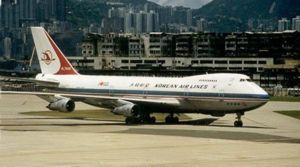
Korean Airlines Flight 007 (KAL007) was a scheduled passenger flight from New York City to Seoul, South Korea between August 31 and September 1, 1983, when it was attacked and shot down by fighter aircraft of the Soviet Union after straying into Soviet airspace near the Kamchatka Peninsula and Sakhalin Island. The reported deaths of 269 passengers, including one sitting Congressman - Conservative Larry McDonald (D-GA), and crew combined with massive Soviet deception as to the location of the crash site provoked international outrage, and may have been a catalyst leading to the collapse of the Soviet Union itself as a political entity.
It being a catalyst for the collapse of the Soviet Union may be inferred from the fact that NATO had decided, under the impetus of the U.S. administration, to deploy Pershing II and cruise missiles in Europe, primarily West Germany. This deployment would have placed missiles just 6–10 minutes striking distance from Moscow. But support for the deployment was wavering and many doubted that the missile deployment would find enough support to effect it. When the Soviet Union shot down Flight 007 with 269 people aboard—an act which U.S. President Ronald Reagan characterized as a "massacre"—enough support was galvanized for the deployment. Many believe this U.S. confrontational demonstration of strength to be a factor in the demise of the Soviet Union.
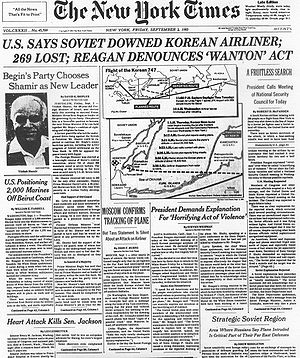
Contents
- 1 The Flight
- 1.1 Possible Pilot Awareness of Deviation
- 2 Stalk and Attack
- 2.1 "I knew this was a civilian plane"
- 2.2 The Osipovich–Air Controller KAL 007 Identity miscommunication
- 2.3 U.S. Electronic Intercept of Shootdown in Progress
- 2.4 See KAL 007: Soviet stalk, shoot down, and rescue mission orders transcripts: simultaneous five sourced
- 3 Flight Data Recorder Chart showing the regaining of control of KAL 007
- 4 Missile damage to people and plane
- 4.1 The Heatseeking missile
- 4.2 The proximity-fused radar guided missile
- 4.3 Inside the Cabin
- 4.4 Capabilities and Damage to Hydraulics
- 4.5 Flight Capability Evaluation
- 4.6 Soviet Command response to Post- Detonation Flight
- 5 The Mystery of the Missing Minutes Solved
- 5.1 See The Soviet/ U.S naval confrontation for real-time photos and a full understanding of the Soviet Harassment of US Search and Rescue Efforts
- 6 Initial Safe landing Report
- 7 American response
- 8 Soviet actions
- 8.1 Flight of the RC-135
- 9 Conspiracy theories
- 9.1 Intentional Deviation
- 10 The Case for Passenger Survival and Abduction
- 10.1 Deception regarding the crash site
- 10.2 Immediate Soviet mission to Moneron
- 10.3 Moneron
- 10.4 No bodies or luggage
- 10.5 The Deployment of the Soviet simulated search fleet
- 10.6 Five Theories for the missing bodies
- 10.7 The finds at Wakkanai and Hokkaido beaches
- 10.8 Deception: Conclusion of the 1991 Staff Study of Committee on Foreign Relations
- 10.9 Shoes and the Romanenko involvement
- 10.10 The Soviet Deception at Sea
- 10.10.1 The Top Secret Soviet Memos
- 10.11 The Russians caught in their lie
- 10.12 The Soviet Black Box Deception I: The Tapes
- 10.12.1 "Last Words" contradiction
- 10.13 The Soviet Black Box Deception II: The Black Box itself
- 11 Senator Jesse Helms and the POW and KAL 007 Connection
- 11.1 The Russian Black Box Acknowledgement
- 11.2 Senator Jesse Helms, KAL 015, and the Grenfell children
- 12 Who ordered the shoot-down
- 13 Conclusions and Aftermath
- 14 Passenger and Crew Breakdown
- 15 Further reading
- 16 See also
- 17 References
- 18 External links
- 18.1 Video Links
The Flight[edit]
KAL 007, a commercial Boeing 747-230B (registration number HL7442) departed John F. Kennedy International Airport in New York on August 31, 1983, stopped at Anchorage, Alaska for refueling at 3:00 AM local time, then departed on the final leg to Seoul-Kimpo International Airport in South Korea. On board, there were 269 occupants comprised of 3 flight crew, 20 cabin attendants, 6 dead-headers (repositioning KAL employees), and 240 passengers (including air marshals). Nationalities (in descending order) were 76 Koreans, 61 Americans, 28 Taiwanese, 23 Japanese, 16 Filipinos, and a lesser number for remaining nationalities. There were 22 children on board under the age of 12 years.[1]
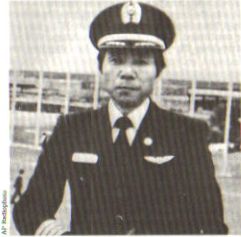
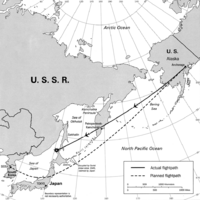
KAL 007's flight plan was to take it southwest from Anchorage to Japan, staying over sea with the Kamchatka Peninsula and Kuril Islands far to the west, then cross Japan's mainland to South Korea. The aircraft's principal mode of navigation was to be the INS, or Inertial Navigation System. Based on radar information it was determined that KAL 007 had in fact strayed off course too far west, placing it directly over Soviet territory more than once. It was about 10 minutes after take-off that the jumbo jet began its deviation to the west. Twenty minutes after, civilian radar at Kenai, Alaska tracked KAL 007 5.6 nautical miles (NM) deviated. Fifty minutes after, military radar at King Salmon, Alaska tracked it at 12.6 NM deviated. One by one, KAL 007 plunged through its navigational checkpoints ever increasing its deviation—60 NM at waypoint NABIE, 100 NM at waypoint NUKKS, and 160 NM at waypoint NEEVA, until 3 hours after take-off, it entered Russian territory north of the port city of Petropavlovsk on Kamchatka. Home to the Far East Fleet Inter-Continental Ballistic Nuclear Submarine Base, Petropavlovsk was bristling with weaponry. For a summary of the ICAO analysis as to why KAL 007 strayed off course, see How KAL 007 was Lost.
Possible Pilot Awareness of Deviation[edit]
The following is the agreed upon data by commentators and investigating bodies such as ICAO which concluded that the deviation was not intentional but due to a lack of situational awareness, and such as the opposite understanding that the deviation and intrusion into Soviet air space was intentional for purposes of saving on fuel by "shortcutting", or intelligence gathering.
The Horizontal Situation Indicator: From Bethel and on, alert pilots could have known much—starting with the Horizonal Situation Indicator The Horizontal Situation Indicator's needle would have alerted the pilots of their course deviation. This is because the cockpit HSI console needle, capable of showing deviation only up to eight miles, would be “pegged” all the way to the side. The pilots, thus, could have known that they were at least eight miles off course. An aircraft HSI generally has an image of a plane directly above the Horizontal Situation Indicator's needle when the aircraft is on course. A needle pointing to the left or to the right of the image would indicate that the plane is deviated left or right of the course. KAL 007's HSI's needle would have been pegged all the way to the right (North). ICAO expanded on the Horizontal Situation Indicator's capability of showing course deviation. The pilots could have known that they were off course by looking at the Horizontal Situation Indicator (HSI) in front of each of them. Though the HSI was primarily designed to show the aircraft's situation with regard to the horizon, the 747's HSI contained an indicator to register deviation from plotted course. “Indications [of being on course] available to the crew would have been a reducing or zero track bar displacement with the HSI display set to INS and a similar reducing or zero cross track error on the CDUs [consoles]. There would have been a similar effect with the VOR track displacement…” [2]
Despite this, strangely enough, at 13:49, the pilots were reporting that they were on course! “007, Bethel at forty niner.” Fifty minutes after takeoff, military radar at King Salmon, Alaska acquired KAL 007 at more than 12.6 miles off course. It had exceeded its permissible leeway of deviation by six times! (Two nautical miles an hour error is the permissible drift from course set by INS.)
Difficulties in making required reports: Furthermore, pilot and copilot could also have been aware of the aircraft's serious deviation because now, much more than 12 miles off course, KAL 007 was too far off course for the pilots to make their required Very High Frequency (VHF) radio reports, and had to relay these reports via KAL Flight 015, just minutes behind it and on course (KAL 007,increasingly off course, would have to rely on KAL 015 three times to transmit its reports to Anchorage Air Traffic Control). That could have alerted them.
At one point in this section of its flight, (14:43 GMT) KAL 007 put a call through a navigational “hookup,” the International Flight Service Station on High Frequency. Flight 007, now too distant to speak directly with Anchorage Controller through Very High Frequency, was transmitting its message indirectly using High Frequency. At another point of this section of the flight, at waypoint NABIE, KAL 007 was too far north to make radar contact with the Very High Frequency Air Traffic Control relay station on St. Paul's Island. KAL 015 relayed for KAL 007. The message was a change in the Estimated Time of Arrival (ETA) for the next waypoint called NEEVA—delaying by four minutes the ETA that KAL 015 had previously relayed on behalf of KAL 007. Since a revised ETA could only be calculated by means of readout information presented by KAL 007's Inertial Navigation Systems Control Display unit, pilot and copilot were once again presented with the opportunity of verifying their position and becoming aware of their enormous deviation.
Contrary wind conditions of KAL 007 and KAL 015: KAL 007 had now passed out of Kamchatka air space and was now a few minutes into international air space over the Sea of Okhutsk and heading in the direction of Terpenie Bay on the west shore of Sakhalin Island. At the same minute (18:05 GMT) that Maj. Osipovich in his Su-15 interceptor has fallen in behind KAL 007 and reports to his ground conroller, "am observing", KAL 007, off course, and KAL 015, on course many miles away, and about 15 minutes beind KAL 007, compare wind velocity and direction. KAL 015 is enountering tailwinds while KAL 007 is encountering headwinds
KAL 015: "Um Um We are now having an unexpected strong tailwind How much do you get there? How much and which direction?" KAL 007: "206. Ask him how many knots?..." KAL 007: "Ah! You got so much! We still got headwind. Headwind 215 degrees, 15 knots." KAL 015: "Is it so? But according to flight plan wind direction 360, 15 knots approximately." KAL 007: "Well, it may be like this." Capt. Chun, by accepting these irreconcilables, has lost his last chance to escape.
Weather radar: There was one last navigational aid to warn the crew. With consoles at the knees of both pilot and copilot, the plane's weather radar could have alerted them, both over Kamchatka and later over Sakhalin, to the fact that they were no longer flying over water, as they ought to have been. Weather radar has two modes—land mapping for clear weather, when it would be possible to look down and see water or land masses as well as the contours of the coast lines and the weather surveillance mode for cloudy weather, when it is necessary to “see through” clouds in order to detect dangerous thunderstorms. In land mapping mode, KAL 007 had only to make sure that the land mass of Kamchatka and the Island string of the Kurile chain would remain to the right. That night, however, KAL 007's weather radar was probably not in land mapping mode, for the weather was inclement. The International Civil Aviation Organization's meteorological analysis would conclude that, “there was extensive coverage of low, medium, and high level clouds over southern Kamchatka associated with an active cold front.(ICAO 1983, section 1.7.1., p. 9.)” ICAO's analysis of KAL 007's weather radar functioning would state, “it was concluded that the radar was not functioning properly or that the ground mapping capability was not used."[3]
An indicator, according to ICAO, of lack of pilot awareness of their flight's deviation from route is the bantering and casual light conversation conducted at the times that awareness of deviation and location would have brought great tension. An example is the time (18:05 GMT) of Maj Ospovich observing KAL 007 while pulling in behind it, then locking on. KAL 007 Flight Crew: "I have heard that there is currency exchange at your airport." "In the airport currency exchange? What kind of money?" "Dollar to Korean money." "That's in the domestic building too, domestic building too."
August 31/September 1, 1983 was the worst possible night for KAL 007 to “bump the buffer” for a complexity of reasons—all of them ominous. It was but a few short hours before the time that Marshal Nikolai Ogarkov, Soviet Chief of General Staff, had set for the test firing of the SS-25, an illegal (according to SALT II agreements) mobile Intercontinental Ballistic Missile (ICBM). The SS-25 was to be launched from Plesetsk, the launch site in northwest Russia which was used for test firing of solid fuel propellant ICBMs—24 minutes later to land in the Klyuchi target area on the Kamchatka Peninsula. Home to the Soviet Far East Fleet Inter Continental Ballistic Missile Nuclear Submarine base, as well as several air bases and Air Defense Missile launching batteries, Petropavlovsk-Kamchatsky on the southern coast of Kamchatka was bristling with weaponry.
Prior to his appointment as Marshal of the Soviet Union and Chief of the General Staff, General Ogarkov had been Chief of the Main Operation Directorate of the General Staff and, as such, had begun and had directed the Strategic Deception Department, or “Maskirovka,” which was charged with hiding Salt 2 violations from United States intelligence. On August 31/September 1, Soviet aerial “jammers” under Maskirovka were sent aloft to prevent United States intelligence eyes and ears from obtaining the illegal SS 25's telemetry data. The SS-25 was in violation of the SALT II agreements on three counts:
1. It was a new kind of ICBM (the first mobile one ever launched).
2. Its telemetry was encoded and encrypted. When a test ICBM reentry vehicle approaches the target, it emits vital data relating to its velocity, trajectory, throw-weight, and accuracy by means of coded (symbolized) and encrypted (scrambled) electronic bursts, which are then decoded and decrypted by Soviet on-ground intelligence gathering stations.
3. The missile as a whole was too large for its reentry vehicle (dummy warhead), raising suspicion that the missile was being developed for new and more advanced warheads than allowable.
Stalk and Attack[edit]
Soviet air defense forces had tracked the aircraft when it first entered airspace over the Kamchatka Peninsula; fighters were scrambled and fired several bursts in front of the plane's nose. Due to the lack of tracer rounds in the Soviet fighter's ammunition, the pilot of KAL 007 was unaware of the bursts. The fighters were ordered back to base when KAL 007 left Soviet airspace over the Sea of Okhotst.
After the Soviets admitted that they had indeed shot down KAL 007, they maintained that they had warned KAL 007 by radio and rounds of tracers. However the Soviet Top Secret Memos to Yuri Andropov revealed by Boris Yeltsin in 1992 [7] contradicted this:
"However in case the flight recorders shall become available to the western countries their data may be used for: - Claiming possibility of erroneous use by the crew of airborne navigational equipment to form various theories based on the data analysis; - Confirmation of no attempt by the intercepting aircraft to establish a radio contact with the intruder plane on 121.5 MHz and no tracers warning shots in the last section of the flight;- Disputing our specification of the flight termination time (the time of the flight termination may be altered within a range from 30 to 40 seconds); - Confirmation of no intelligence mission by the plane on the strength of argument that within the last 30 minutes of flight during which the voice recorder registered oral communications of the crew nothing was said that might disclose the reason of incursion of the airplane into the airspace of the USSR. ...CONCLUSION In connection with above, it seems unnecessary to transfer the flight recorders to the International Civil Aviation Organization (ICAO) or any third party willing to decipher and analyze of their data. Head of the Group Lieutenant-General of Aviation MAKAROV Staff of the Group Lieutenant-General Engineer TICHOMIROV Major-General Engineer DIDENKO Major -General of Aviation STEPANOV Major -General of Aviation KOVTUN Corresponding Member of Academy of Sciences of the USSR FEDOSOV 28 November 1983" -
When KAL 007 re-entered Soviet airspace, this time over Sakhalin Island, fighters were again scrambled with orders to "destroy the target." The Commander of the Soviet Far East District Air Defense Forces, General Valeri Kamensky,[4] was adamant that KAL 007 was to be destroyed even over neutral waters but only after positive identification showed it not to be a passenger plane. His subordinate, General Anatoli Kornukov, commander of Sokol Air base (later to become commander of the Russian Air Force), was adamant that there was no need to make positive identification as "the intruder" had already flown over Kamchatka.
General Anatoly Kornukov (to Military District Headquarters-Gen. Kamenski): (5:47)
"...simply destroy [it] even if it is over neutral waters? Are the orders to destroy it over neutral waters? Oh, well."
Kamenski:
We must find out, maybe it is some civilian craft or God knows who."
Kornukov:
"What civilian? [It] has flown over Kamchatka! It [came] from the ocean without identification. I am giving the order to attack if it crosses the State border."[5]
"I knew this was a civilian plane"[edit]
Until 1996, there had been a controversy concerning the identity of KAL 007 by the Soviets as a civilian passenger plane, rather than a U.S. RC-135 Reconnaissance plane. But that ended with the acknowledgment of Gennadie Osipovich, the SU-15 Interceptor pilot, that he indeed knew he was shooting down a civilian passenger plane and that he did see its navigation lights blinking.
"From the flashing lights and the configuration of the windows, he recognized the aircraft as a civilian type of plane,....'I saw two rows of windows and knew that this was a Boeing,' he said. 'I knew this was a civilian plane. But for me this meant nothing. It is easy to turn a civilian type of plane into one for military use.(New York Times, Dec. 9, 1996).
At 18:26 GMT two air-to-air missiles from an Su-15 Flagon piloted by Major Gennadi Osipovich were fired at the jumbo jet,[6] causing it to spiral down from 35,000 feet and after a 12-minute descent crash into the sea near Moneron Island.
The Osipovich–Air Controller KAL 007 Identity miscommunication[edit]
In his September 9, 1996 interview Osipovich stated that he knew that it was a civilian Boeing from the double rows of windows. He told ground controllers that there were blinking lights, which he believed should have alerted them to the fact that the plane was a transport. But he did not tell them that the aircraft was specifically a Boeing 747. Also clear, is that KAL 007's blinking navigational lights were also not communicated upward:
"From the flashing lights and the configuration of the windows, he recognized the aircraft as a civilian type of plane, he said. 'I saw two rows of windows and knew that this was a Boeing,' he said. 'I knew this was a civilian plane. But for me this meant nothing. It is easy to turn a civilian type of plane into one for military use.'... Osipovich also revealed that in the pressure of the moment, he did not provide a full description of the intruder to Soviet ground controllers. 'I did not tell the ground that it was a Boeing-type plane,' he recalled. 'They did not ask me.' He did, however, tell Soviet ground controllers that the plane had blinking lights on, which he says was an indication that it could be a transport plane."
That the omission of the identity of KAL 007 as a Boeing by Osipovich is confirmed by ground personnel to the Combat controller, Lt. Col. Titovnin:
It is clear that attack was made on the intruder plane not because it was considered a continuing threat, but because it would soon escape into neutral waters.Titovnin: The commander has given orders that if the border is violated—destroy [the target].
Lt. Col. Maistrenko: ...May [be] a passenger [aircraft]. All necessary steps must be taken to identify it.
Titovnin: Identification measures are being taken, but the pilot cannot see. It’s dark. Even now it’s still dark.
Maistrenko: Well, okay. The task is correct. If there are no lights—it cannot be a passenger [aircraft].
Kornukov: Oh, [obscenities] how long does it take him [Maj. Osipovich in his Su-15] to get into attack position. He is already getting out into neutral waters. Engage afterburner immediately.Bring in the MiG 23 as well...While you are wasting time, it will fly right out.
U.S. Electronic Intercept of Shootdown in Progress[edit]
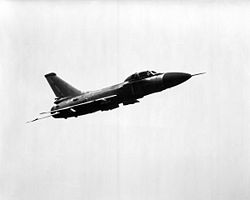
The following is the actual shootdown transmissions from the Sukhoi-15 as intercepted by the U.S. (NSA), in combination with the commands from Soviet Combat Air Control handed over by the Russian Federation ("Transcript of Communications. USSR Air Defence Command Centres on Sakhalin Island" of Information Paper 1. ICAO, 1993) NSA Electronic intercepts have minute and second specified.
Osipovich: (18:22:02) The target is decreasing speed.
Osipovich: (18:22:17) I am going around it. I'm already moving in front of the target.
Titovnin: Increase speed, 805 [call sign of Osipovich's Sukhoi-15].
Osipovich: (18:22:23) I have increased speed.
Titovnin: Has the target increased speed, yes?
Osipovich: (18:22:29) No, it is decreasing speed.
Titovnin: 805, open fire on target.
Osipovich: (18:22:42) It should have been earlier. How can I chase it? I'm already abeam of the target.
Titovnin: Roger, if possible, take up a position for attack.
Osipovich: (18:22:55) Now I have to fall back a bit from the target.
Osipovich’s irritation with his controller reflects the fact that, in contrast with the freedom of initiative given to an American pilot in combat, a Soviet pilot must be “vectored” and commanded for almost every move he makes.
KAL 007 leveled off at 18:23 at 35,000 feet. Now it would have only 3 minutes of flying time before Osipovich’s “Anab” medium range air-to-air missile would come streaking toward it from the rear. And, it was now General Kornukov’s turn to exhibit irritation and concern. From his communication to Gerasimenko, it is clear that KAL 007 was shot down by the Soviets not because it posed a threat to them, but because it was escaping.
Gen. Kornukov: Oh, [obscenities] how long does it take him to get into attack position, he is already getting out into neutral waters. Engage afterburner immediately. Bring in the MiG 23 as well... While you are wasting time it will fly right out.
With back-up from the MiG 23 (call sign 163), and at a distance of eight kilometers, Major Osipovich executes what he believes will be the destruction of KAL 007 (he has distanced himself from the target so that his interceptor will not be struck by fragments of the exploding passenger plane).
Titovnin: 805, try to destroy the target with cannons.
Osipovich: (18:22:37) I am dropping back. Now I will try a rocket.
Titovnin: Roger.
MiG 23 (call sign 163): (18:23:49) Twelve kilometers to the target. I see both [the Soviet interceptor piloted by Osipovich and KAL 007].
Titovnin: 805, approach target and destroy target.
Osipovich: (18:24:22) Roger, I am in lock-on.
Titovnin: 805, are you closing on the target?
Osipovich: (18:25:11) I am closing on the target, am in lock-on. Distance to target is eight kilometers.
Titovnin: Afterburner.
Titovnin: AFTERBURNER, 805!
Osipovich: (18:25:16) I have already switched it on.
Titovnin: Launch!
Osipovich: (18:26:20) I have executed the launch.
Osipovich: (18:26:22) The target is destroyed.
Titovnin: Break off attack to the right, heading 360.
Osipovich: (18:26:27) I am breaking off attack.
There were no survivors found, and no bodies, body parts or tissues found on the surface of the sea. See Rescue 007:The Rescue for transcripts of the Soviet Search and Rescue orders.
See KAL 007: Soviet stalk, shoot down, and rescue mission orders transcripts: simultaneous five sourced[edit]
not a reconstruction or re-enactment, but the dramatic unfolding of the events themselves, as they were recorded by all sides - American, Japanese, and Soviet
Flight Data Recorder Chart showing the regaining of control of KAL 007[edit]
This ICAO graphing of the deciphered Digital Flight Data Recorder of KAL 007's first minute and 44 seconds of post attack flight shows the regaining of control by Capt Chun. Following the "altitude" and "pitch" lines, Captain Chun's regaining control is evident through the immediate 113 second arc upward and dive downward, then the 10 second pull-up taking KAL 007 to pre missile attack altitude, and then the beginning gradual descent. Note the sharp decrease in "acceleration" as Capt. Chun levels off from the pull up - belying the Media descriptions that KAL 007 uncontrollably "plunged", "dived", "hurtled down", "cartwheeled", etc., to its destruction after it was hit.
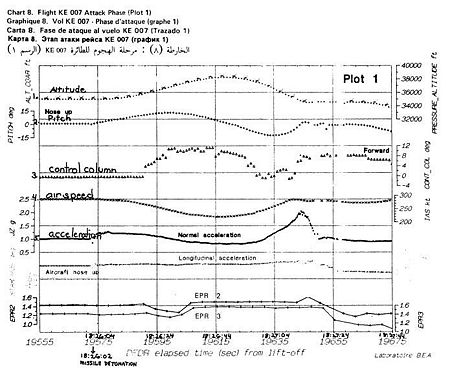

Missile damage to people and plane[edit]
What can be learned of the damage and lack of damage to KAL 007 is derived from its deciphered Black Box (Cockpit Voice Recorder and Digital Flight Data Recorder) tapes for the duration of the first minute and 44 seconds of its post detonation flight of at least 12 minutes, and from the Soviet real time communiques and radar trackings for the remainder of its flight .
The Heatseeking missile[edit]
In a two-second interval, the Soviet pilot launched two R-98 (ANAB) air-to-air medium range missiles. The second missile, a heat seeker, was designed to “home in” onto the exhaust of aircraft engines, exploding on contact. As the International Civil Aviation Organization analysis will show, this missile missed.
6)."The interceptor pilot [Osipovich] stated that the first missile hit near the tail, while the second missile took off half the left wing of the aircraft." (ICAO '93 report, pg. 39, 1.16.1.5) "The interceptor's pilot's statement that the second missile took off half of the left wing was probably incorrect. The missiles were fired with a two-second interval and would have detonated at an equal interval. The first detonated at 18:26:02 hours. The last radio transmissions from KE 007 to Tokyo Radio were between 18:26:57 and 18:27:15 hours using HF1 [High Frequency]. The HF 1 radio aerial of the aircraft was positioned in the left wing tip suggesting that the left wing tip was intact at this time. Also, the aircraft's manoeuvres after the attack did not indicate extensive damage to the left wing." (ICAO '93 report, pg. 39, 1.16.1.
In addition, the co-pilot reported to Capt. Chun twice during the flight after the heat seeker missile's detonation, "Engines normal, sir."
The proximity-fused radar guided missile[edit]
The first missile was radar-controlled and proximity-fused, designed to detonate 50 meters from an aircraft. It exploded at exactly 18:26:02—exactly five hours, 26 minutes and 18 seconds after KAL 007 began its taxi to takeoff from Anchorage, Alaska. Sending fragments forward, this missile either severed or unraveled the crossover cable from the left inboard elevator to the right elevator. This with damage to one of the four Hydraulic systems (3 of the 4 systems were damaged or out), caused KAL 007 to ascend from 35,000 ft. to 38,250 ft. at which point Capt. Chun, disengaging the auto-pilot and taking manual control, was able to bring it down.
The fragments also caused punctures to the pressurized passenger cabin. All the punctures together amounted to a total of 1 3/4 sq. feet, too small, even together, for anyone to be sucked out by decompression. This was determined by the 11 seconds it took for the air to begin rushing out of the cabin before the alarm was set off picked up by the Cockpit Voice Recorder.[7]
Inside the Cabin[edit]
Congressman Larry McDonald, seated in an aisle seat of the first class section was most likely unharmed though there may well have been wounded or dead in the rear section struck by missile fragments. There was a sufficient supply of oxygen for comfortable breathing. Aviation Specialist Dr. Malcolm Brenner explains: “Crew members and passengers would have about one minute of expected useful consciousness unless they successfully began receiving oxygen from an oxygen mask.” Well within that critical “one minute of expected useful consciousness,” the oxygen masks had already deployed and, because of the upward pitch of the aircraft's nose for most of its ascent leg of the 1 minute and 13 second arc upward, the masks were drifting back toward or behind the heads of the passengers, within easy reach (If airline regulations had been followed, adults would have donned their masks first before putting them on their children).
At 6:26:34, thirty-two seconds after missile detonation, the following consecutive messages were broadcast over the public address system in English, Korean, and Japanese: “Attention, Emergency Descent. Put out your cigarette. This is an Emergency Descent. Put the mask on your nose and mouth and adjust the headbands.” When one of the flight crew radioed Tokyo Airport, one minute and two seconds after missile detonation, his breathing was already "accentuated" as he was then speaking through the mike located in his oxygen mask, "Korean Air 007 ah… We are… Rapid compressions. Descend to 10,000.” Two expert witnesses testified at a Court of Appeals trial on the issue of pre-death pain and suffering. Captain James McIntyre, an experienced Boeing 747 pilot and aircraft accident investigator, testified that Flight 007's tail was struck by shrapnel from a proximity missile. This shrapnel probably caused a hole smaller than two feet in diameter, resulting in decompression but leaving the passengers sufficient time to don oxygen masks. McIntyre testified that, based upon his estimate of the extent of damage the aircraft sustained, all passengers survived the initial impact of the shrapnel from the missile explosion. In McIntyre's expert opinion, at least twelve minutes elapsed between the impact of the shrapnel and the crash of the plane, and the passengers remained conscious throughout.[8]
Capabilities and Damage to Hydraulics[edit]
With only one of the four redundancy designed hydraulic systems fully operational (making control difficult, but by no means impossible), and with wing flaps up, “control was reduced to the right inboard aileron and the innermost of the spoiler section on each side.” G. Norris and M. Wagner in Boeing (MBT Publishing, Osceolo, WI 1998) explain (pg. 128) the safety benefits of multiple redundant hydraulic systems for the Boeing 747,
"The hydraulics provided actuation for all the primary flight controls; all secondary flight controls (except leading edge flaps); and landing gear retraction, extension, gear steering, and wheel braking. Systems 1 and 4 could be used for all purposes [KAL 007's hydraulic system no. 4 was undamaged], while systems 2 and 3 were normally used for flight control only... System 4 also had a third electrical power source. Each primary flight control axis received power from all four hydraulic systems."
KAL 007 would exhibit a flight capability after the attack which would include a pull up to pre detonation altitude 0f 35,000 ft., a gradual descent until leveling out at 16,424 ft (5,000 meters), a flight of almost 5 minutes at that altitude and then slow spiral descent of Moneron Island, the only land mass in the whole Tatar straits. During this flight it was able also to negotiate turns. One of its four hydraulic systems evidenced no damage from the missile attack. There are three incidents where aircraft with one or even no hydraulic systems operational were able to fly and maneuver. In July 1971, Pan Am's flagship aircraft, a Boeing 747, registered N747PA, hit a light gantry upon take-off from San Francisco International Airport. The crew had misjudged the speed of the aircraft and the length of the runway. As the plane pulled up sharply in an attempt to clear it, the rear end of the fuselage came down on the gantry. The aircraft continued to take off and with the gantry stuck in its cargo area and with three of the hydraulic systems destroyed. The jumbo jet circled the airport and made a safe landing—still with the gantry stuck through its cargo area and only one hydraulic system operational. On July 19, 1989, Capt. Al Hanes flew United Flight 232 with zero hydraulic to an emergency landing at Sioux City, Iowa airport. The crew had limited control by using thrust modulation (symmetric thrust for pitch, differential thrust for yaw/roll). The aircraft eventually skidded of the runway and overturned in a field killing 110 of its 285 passengers and one of the 11 crew members. The third incidence involved the attempted shootdown of a DHL aircraft. On November 22, 2003, a missile took out portions of the left wing and collateral damage took out all the hydraulic systems. As in the case of the 1989 United Airlines Flight 232, the Captain could only use thrust to modify pitch, speed and altitude and vary throttles asymmetrically to control yaw and turn the aircraft. There were no casualties as the aircraft safely returned and landed at Baghdad International airport.
Flight Capability Evaluation[edit]
The measure of KAL 007 potential and actual controllability are the following 10 indications :
- Sufficient oxygen for pilot alertness (flight crew speaking through microphones within oxygen masks).
- All engines were operating normally (as reported twice by co-pilot to Capt. Chun after missile detonation).
- Electrical system was operative (otherwise the radio would not have operated).
- Demonstrated pilot ability to decrease speed of KAL 007 in its downward phase (If he would not have been able to do so, the aircraft would continue to increase its downward acceleration—only to collide with the water in from 2 to 2 1/2 minutes rather than maintain its over 12 minute post-detonation flight.
- KAL 007 was able to regain its pre-hit altitude almost exactly. (It is highly unlikely that KAL 007 regained exact altitude after its arc by chance.)
- KAL 007 was able to regain its pre-missile hit rate of forward acceleration.
- Captain Chun was able to bring KAL 007's nose (pitch) to the plane's exact level of flight.
- For over 4 minutes (18:31 - 18:35), KAL 007 maintained level flight altitude of 5,000 meters only to begin a spiral descent over tiny Moneron Island, 3 1/2 miles E-W by 4 1/2 miles N-S - the only land mass in the whole Tatar straits.
- Material evidence that passengers had enough time to prepare for emergency water ditching [8]
- Contrary to the statement of interceptor pilot that his missile had taken off the left wing of KAL 007, his missile had in fact missed, and the left wing was intact (all engines normal, noted ability to maneuver, high frequency broadcast made after attack using HF antenna 1. located on tip of left wing)
Soviet Command response to Post- Detonation Flight[edit]
Contrary to what would have been expected to the Interceptor pilot's call, "Target destroyed", the Soviet command, from General on down indicated surprise and consternation at KAL 007's continued flight, and ability to regain its altitude and maneuver. This consternation continued through to KAL 007's subsequent level flight at altitude 16,424 ft. and then through its spiral descent over Moneron Island.
18:28: Lt. Col. Novoseletski: Well, what is happening, what is the matter, who guided him in, he locked on, why didn't he shoot it down?
18:28 Lt. Col. Gerasimenko: The target turned to the north. Kornukov: The target turned to the north?
18:29 Kornukov: Well, I am asking, give the order to the Controller, what is wrong with you there? Have you lost your tongues?
18:29: Kornukov: Well, I understand, I do not understand the result, why is the target flying? Missiles were fired. Why is the target flying? [obscenities] Well, what is happening?
18:29: Lt. Col. Gerasimenko: Comrade General, I gave the order to the Chief of Staff, the Chief of Staff to the Controller, and the Controller is giving the order to...
18:30: Kornukov: Well, how long does it take for this information to get through, well, what, [you] cannot ask the results of firing the missiles, where, what, did [he] not understand or what?
18:32: Kornukov: Altitude...what is altitude of our fighter and the altitude of the target? Quickly. the altitude of the target and the altitude of the fighter?... Why don't you say anything?...Gerasimenko!...
18:33: Gerasimenko: Gerasimenko. Altitude is 5,000 [16,424 ft.]. Kornukov: 5,000 already?
18:34: Gerasimenko: Affirmative, turning left, right, apparently it is descending. Kornukov: Destroy it, use the 23 to destroy it, I said!
The Mystery of the Missing Minutes Solved[edit]
At the Altitude of 35,000 feet at which KAL 007 was attacked, it should have taken 2 to 2 1/2 minutes to reach the surface of the sea. This figure is arrived at by both simulator replication and actual occurrences of planes that have fallen to their destruction. Yet, it had taken 12 minutes for KAL 007 to have gotten from 35,000 feet to 1,000 feet at which it could no longer be tracked due to the curvature of the earth.
For comparison, a China Airlines jumbo jet fell 32,000 feet in less than two minutes after all four of its engines failed but the pilot restarted them and flew 500 miles with a damaged tail before making an emergency landing in San Francisco. The Boeing 747 fell from a cruising altitude of 41,000 feet to 9,000 feet. The plane fell 32,000 feet in something less than two minutes. The rate of descent would have been 267 feet per second. Had KAL 007 "plummeted" toward the sea at that rate, its fall would have taken about two minutes and 11 seconds - not 12 minutes.
On September 1, Secretary of State George Shultz had stated: "At 1826 hours the Soviet pilot reported that he fired a missile and the target was destroyed. At 1830 hours [or 4 minutes later] the Korean aircraft was reported by radar 5,000 meters [16,424 feet]. At 1838 hours [12 minutes after being hit] the Korean plane disappeared from the radar screen." Most people, including researchers and media personnel, assumed that "disappeared from the radar screen" meant that KAL 007 had exploded and disintegrated. But the true explanation would become available from 1992 onwards.
The mystery of the disparity in time was solved by the handover by the Russian Federation of the Black Box and the real time Russian military communications of the shootdown. KAL 007 had not "plunged" down after the attack. It had gradually descended for 4 minutes after the attack and then leveled off at 16,424 feet (18;30-31 GMT), and at this altitude continued its post-attack flight for almost 5 minutes (18:35 GMT), and only then continue a descent in spirals until being tracked at 1,000 feet above sea level and 2.6 miles from Moneron Island.
"The last plotted radar position of the target was 18:35 hours at 5,000 meters." (ICAO 1993, pg. 53, para. 2.15.8)Gen. Kornukov (18:32): Tell the 23 [MiG]... afterburner. Open fire, destroy the target, then land at home base.
Lt. Col. Gerasimenko (acting commander, 41st Fighter Regiment, viewing radar): Roger
Kornukov: Altitude... What is the altitude of our fighter and the altitude of the target? Quickly. The altitude of the target and the altitude of the fighter!
...Why don't you say anything? Gerasimenko!
Gerasimenko (18:33): Gerasimenko. Altitude of target is 5,000.
Kornukov: 5,000 already?
Gerasimenko (18:34): Affirmative, turning left, right, apparently it is descending.
[edit]
Initial Safe landing Report[edit]
After Action Report MapRight after KAL 007 was reported missing, there was a report conveyed via phone by Orville Brockman, the Washington office spokesman of the Federal Aviation Administration to Tommy Toles, the press secretary of Cong. Larry McDonald. This report was that the FAA representative in Tokyo,. Dennis Wilhelm had been informed by a Mr. Tanaka of the Japanese Civil Aviation Bureau (Counter-part to the FAA) that "Japanese self-defense radar force confirms that the Hokkaido radar followed Air Korea to a landing in Soviet territory on the island of Sakhalinska S-a-k-h-a-l-i-n-s-k-a and it is confirmed by the manifest that Congressman McDonald is on board". This report would indicate that KAL 007 had made a 180 degree turn as it would have had to do so to land on Sakhalinsk Island after having already passed it (as it had been attacked in international waters just outside the 12 mile Soviet claimed territorial border west of Sakhalin), and it could, on the other hand indicate the eastern heading portion of KAL 007's spiral descent around 4 1/2NM by 3 1/2NM Moneron Island to a landing east of Moneron and West of Sakhalin (Moneron and Sakhalin islands are slightly less than 24 naut. miles from each other and the lines of their respective 12 mile territorial borders intersect - see Task Force 71 After Action Report map below). The statement "to a landing in Soviet territory on the island of Sakhalinska" under this view would describe a report by Japnese self-defense force, and possibly by its reporting radar station, which was inexact but rather to indicate the general area in this sector. The Hokkaido tapes are not in the public domain.
American response[edit]
Initially the news flashed in the early morning hours of September 1 would report that KAL 007 had disappeared over the Pacific; it would be a matter of hours before the world would know something more ominous. President Reagan, vacationing at his California ranch, would cut it short and fly to Washington. Just before boarding Air Force One, Reagan hinted that the actions by the Soviets were somewhat worse than their invasion of Afghanistan in 1979: "While events in Afghanistan and elsewhere have left few illusions about the willingness of the Soviet Union to advance its interests through violence and intimidation, all of us had hoped that certain irreducible standards of civilized behavior nonetheless obtained," he declared. "But this event shocks the sensibilities of people everywhere...What can we think of a regime that so broadly trumpets its vision of peace and global disarmament and yet so callously and quickly commits a terrorist act to sacrifice the lives of innocent human beings?" [9]
Secretary of State George Shultz would have a meeting in Madrid, Spain later in the week with Soviet Foreign Minister Andrei Gromyko on the subject of arms control. For the previous few months the Reagan administration felt that things were opening up between the United States and the Soviet Union; the shooting of KAL 007 set things back. Instead of talking arms control, Shultz made heated demands of Gromyko as to what happened to the plane. Jeane Kirkpatrick, the U.S. ambassador to the United Nations and at the behest of Reagan, placed a large television in the Security Council and played the recorded tapes of the fighter pilots and ground control for the world to hear:
- "I see it, visually and on radar . . . The A.N.O. [air navigational lights] are burning. The [strobe] light is flashing . . . What are instructions? . . . I'm dropping back. Now I will try a rocket . . . I am closing on the target . . . I have executed the launch. The target is destroyed."
The Soviet delegation had their backs turned towards the screen even as they repeated the Tass statement on the loss of the plane.
Reagan would spend much of two days drafting a carefully-prepared speech which he presented on national television September 5. Calling it a "crime against humanity" that had "absolutely no justification, either legal or moral," he used the speech as an indictment of the Soviets in the court of public opinion, using the word "massacre" six times to describe it. Reagan asserted in a key passage "This attack was not just against ourselves or the Republic of Korea. This was the Soviet Union against the world and the moral precepts which guide human relations among people everywhere." [10]
On September 15, 1983, President Reagan would order the Federal Aviation Administration (FAA) to revoke the license of Aeroflot Soviet Airlines to operate flights to and from the US. Aeroflot flights to North America were consequently available only through Canadian and Mexican cities. Aeroflot service to the U.S. was not restored until April 29, 1986. In addition, Reagan failed to follow through on his tough talk by employing any of the means possible to punish the Soviets, such as trade sanctions. In fact, over time, his administration increased trade with the Soviet Union. Already on September 1, 1984, the Associated Press reported: “Secretary of State George Shultz says the Soviet Union’s shooting down of a South Korean airliner one year ago … should not preclude improvement of relations.”
Searches for the remains of the plane, believed lost in the waters to the southwest of Sakhalin Island, proved fruitless; U.S., Korean, and Japanese search vessels were harassed continually by Soviet vessels.[11]
Soviet actions[edit]

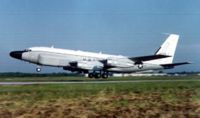
The Soviets were tight-lipped about the affair for two days. Their only response was through the Tass news agency, in which it was stated that the plane was on a spying mission and was shot down after crossing over their territory.
Then from the Kremlin came the order: the Soviets officially declared that KAL 007 was on a spy mission, and as a spy plane it was deliberately shot down. All of the talk of innocent passengers lost was dismissed as "hulla-balloo", and they said that they were prepared to do it again.
Thinking that they may have made a bad public-relations impression, on September 9 Marshal Nikolai Ogarkov, the Soviet Chief of Staff, went on television to give the Kremlin's view of what happened, repeating the spy plane story, but insisting the plane had been warned to land first. Tracing the plane's route with a pointer on a map behind him, he explained that ground controllers had mixed KAL 007 with a U.S. reconnaissance plane, and the order to shoot it down came not from the Kremlin, but from a far east commander in a military decision, raising a question as to whether or not the Soviet civilian leadership had actual control over its military, and leaving the world to wonder if this "hair trigger mentality" could result in a major conflagration.[12] Needless to say, Ogarkov's television appearance did little to absolve the Soviets of responsibility.
Flight of the RC-135[edit]
During the early-morning hours of August 31-September 1, a United States Air Force RC-135 Cobra Ball reconnaissance plane was engaged in a mission to gather electronic intelligence, flying a "racetrack" course at sea off the Kamchatka Peninsula. It was tasked with capturing the telemetry of the SS-25 missile, illegal according to Salt ll agreements, which the Soviets were to launch that night from Plesetsk in north west Russia to come down in the Klyuchi target range on Kamchatka. For hours the Soviets were aware of this flight, having picked it up on radar while in its inward track (i.e. the track closest to the coastline) before it would disappear from the radar on its outward track. The racetrack course was repeated several times during the night until KAL 007 arrived on the scene, following closely the inward track of the RC-135; since the jumbo jet did not veer off course as the Soviets expected it to do (assuming they thought it was the RC-135), they had an opportunity to intercept it.
Whether the RC -135, configured as a Cobra Ball, was able to pick up the "chatter" from Soviet command posts and capture the radar stations "lighting up" one after another tracking the "intruder" aircraft, as an RC-135 configured as a Rivet Joint could, has been contested. If it had been able to do so, it would also have known the reason for the heightened Soviet activity, and could have warned its own immediate command -the Strategic Air Command for the flight crew and the National Security Agency for the Electronic specialists (the "Ravens"), Anchorage Air Traffic Control (which would warn KAL 007), and even the President's Office through initiating a "Critic Report". A Critic report is the highest intelligence report that intelligence agencies can issue. Being sent at Flash precedence, it overrides everything else on the net. A ground station would be unable to override the Critic. The Critic reaches its designated receiver within 10 minutes (often less) - thus the disaster would have been be averted (The KAL 007 Massacre, Franz A. Kadell, Western Goals, Virginia, 1985 pg. 107).
Click here [9] for two reports by RC-135 crew members (one of which flew back on return flight with actual crew of the RC-135 of that night) that indicate that KAL 007 was known by the RC-135 listening in to Soviet ground stations to have intruded into Russian airspace.
There has always been a question concerning the capability, and the actualization of that capability, of the RC-135 to become aware of KAL 007 as it penetrated into Soviet air space and to warn it. During the civil litigation for damages to the families of the victims of the shoot-down, Chief Justice of the District Court of Washington, D.C., Aubrey Robinson, ruled out legal recourse to finding out on grounds that it would endanger National Security. He allowed only, on April 18, 1984, questions to the military, "but only in respect to uncovering the legal duty [of the military] to warn or advise civilian aircraft" (KAL 007: The Cover-Up, David E. Pearson,Summit Books, London, New York, 1987, pg. 305)
.The RC-135 was manufactured by Boeing, and is a military variant of the civilian 707 passenger jet. Configured in several versions, this aircraft was used to conduct airborne surveillance from the 1960s through to the mid-1990s, and many were on routine patrols in the western Pacific Ocean monitoring Soviet activity.
Seymour Hersh, writing in his book The Target is Destroyed, mentioned what was called "psychological operations" (PSYOPS) programs carried out by the United States against the Soviets. These programs included massive naval exercises and simulated attacks carried out in proximity of critical Soviet bases. This, combined with the Strategic Defense Initiative (SDI) initiated by President Reagan, Cold War tensions rose to high levels. Just a scant four weeks from the KAL 007 disaster, operation Able Archer was conducted by the United States and its European allies; a reflection seen on Soviet radars was interpreted by many to be an actual first strike by intercontinental ballistic missiles. Only the interpretation by a Soviet general that it was in reality a computer glitch from a malfunctioning satellite prevented a possible nuclear war.
Conspiracy theories[edit]
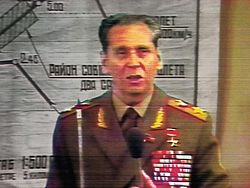
Spy plane theory: According to this theory, KAL 007 was "bait" used by the United States to test Soviet response to a flight intrusion into their borders; the RC-135 would be listening in on the response, while the civilian plane would expected to be released from any forced landing, its crew claiming innocence due to being "lost".
The fact of the matter was the RC-135 was a virtually-windowless plane; the Soviet fighter pilots reported the contact as having multiple windows. Major Osipovich, the man who fired the fatal shot, stated he knew it was a civilian plane:
"I saw two rows of windows and knew that this was a Boeing. I knew this was a civilian plane. But for me this meant nothing. It is easy to turn a civilian type of plane into one for military use." (New York Times interview, September 9, 1996).
A Boeing 747, at nearly twice the size of an RC-135 and with its distinctive cockpit hump, is unmistakable for anything else in the air, and in 1983 none were in service with the U.S. military.
Assassination theory: The most prominent passenger on KAL 007 was a United States Congressman from Georgia, Democrat Larry McDonald, a fiery anti-communist who was recently made the president of the John Birch Society, an organization dedicated to exposing the truth of communism and the Soviet Union. The theory goes was that the Soviets had wanted to silence McDonald, and being aware of his presence on the flight (he was on his way to Seoul for the 30th anniversary of the U.S./South Korean Mutual Defense Treaty) sent the fighters aloft; it was sheer luck that the plane had drifted into Soviet airspace. About fifteen minutes behind was another flight, KAL 015, carrying to the anniversary celebration senators Jesse Helms (R-North Carolina), Steve Symms (R-Idaho), and Congressman Caroll Hubbard (D-Kentucky), all anti-communist like McDonald and also attending the ceremony in Seoul.
The theory specified that the Soviets knew of McDonald's activities and wished to silence him, despite the presence of several more tempting targets on the other flight. There is no known evidence that the Soviets were even aware that McDonald was on the plane at all. They would find out after the news media broke the story on September 1.
Intentional Deviation[edit]
There are three intentional deviation theories, the third related to the Assassination theory.
1. One theory posits the pilots making an intentional deviation shortening the route to Seoul by crossing Kamchatka, saving fuel in the process. Though considered by several law firms in the damage litigations of the civil trial, this theory has been generally rejected because of the dangers involved, and because of the weakness of personal motivation presented to the pilots.
2. The second theory, is that of Capt. Parks, the pilot of the accompanying flight to KAL 007, KAL 015. He was a former superior officer in the South Korean Air Force and personal friend of Capt. Chun, the pilot of KAL 007, and believes his theory fit the personal profile of his friend. Park believes that the coordinates for the flight, or, conversely, properly entered, but when the aircraft had already rolled from "ramp position" had been improperly entered into the Inertial Navigation System (INS) of KAL 007. Chun realized this only when in flight, and rather than dump fuel and return to Anchorage (required by KAL), and face fine, possible demotion and humiliation, decided to "wing it" by Magnetic Heading, rather than the INS, and thus strayed into Soviet territory.
3. The third theory suggests a possible intentional deviation as part of a plan that the pilots may not have been aware of: The pilots set the autopilot mode to INS but only after the flight had passed outside of the permissible 7.5 nautical mile (NM) "Desired Track Capture Envelope" to switch to INS from the Magnetic Heading. This occurred after the Cairn Mountain, Alaska, way point. At Cairn Mountain, the flight was already 6.5 miles off course but still within the 7.5 envelope. If Air Traffic Control for the Cairn Mt. sector had notified KAL 007 that they had deviated from the course, they could have still corrected the situation by switching the NAV mode from Magnetic Heading to INS. Of all the flights that day, Anchorage Air Traffic Control for the sector failed to mark the positions of only two - KAL 007 and KAL 015. Congressman McDonald was aboard KAL 007; Senators Jesse Helms and Steven Symms and Congressman Carroll Hubbard Jr. were aboard KAL 015. This failure of Air Traffic Control to mark down the position of KAL 007 and KAL 015 (and only those two flights) is both unfortunate and curious.
The Case for Passenger Survival and Abduction[edit]
Contrary to the Interceptor pilot's report that "the target is destroyed", the Russian Federation handover of the original real-time communications of the shootdown show horrified Soviet commanders viewing, and relating what they are viewing, KAL 007 leveling out at 5,000 meters (at 18.31) and continuing at that altitude for over 4 minutes (18:35), turning north, approaching tiny Moneron Island (4 1/2 miles by 3 1/2miles), the only island in the whole Tatar straits, and then making a spiral descent.
General Anatoly Kornukov, Commander of Sokol Airbase on Sakhalin: "Well, I understand, I do not understand the result, why is the target flying? Missiles were fired. Why is the target flying? [obscenities] Well, what is happening?"
Debriefed former Soviet military men who had served on the Soviet maritime across from Sakhalin and Moneron Island and who had immigrated to Israel reported that the Soviet radar stations, including those at Komsomolsk-na-Amura and Edinka, tracked KAL 007 in its spiral descent until it was 1,000 feet above sea level (the point at which Soviet radar could not capture the aircraft due to curvature of the earth). This information was conveyed to the Minority Staff (Republican) under Senator Jesse Helms of the Senate Committee on Foreign Relations which issued in its Republican Staff Report [draft] of 1991 [13] this concluding statement -Lt. Col. Novoseletski: "Well, what is happening, what is the matter, who guided him in, he locked on, why didn’t he shoot it down?"
“KAL 007 PROBABLY DITCHED SUCCESSFULLY, THERE MAY HAVE BEEN SURVIVORS, THE SOVIETS HAVE BEEN LYING MASSIVELY, AND DIPLOMATIC EFFORTS NEED TO BE MADE TO RETURN THE POSSIBLE SURVIVORS.”
Deception regarding the crash site[edit]
Contrary to Russian insistence that they had no knowledge of where KAL 007 had come down, and had maintained lack of knowledge all through the Search and Rescue operations lasting more than two months, they knew exactly where KAL 007 was coming down, and where it had come down, which was over, and then near, Moneron Island. Here is what the Soviet high command saw and said as they saw KAL 007 spiraling down over Moneron Island in Soviet territorial waters:
Immediate Soviet mission to Moneron[edit]
Within minutes of the shootdown, two missions involving rescue helicopters, KGB patrol boats, and civilian ships were ordered by the Soviets to Moneron Island.[14]
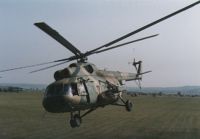
Gen. Strogov (Deputy Commander for the Soviet Far East Military District):
"The border guards. What ships do we now have near Moneron Island, if they are civilians, send [them] there immediately."
Lt. Col Novoseletski: "Prepare whatever helicopters there are. Rescue helicopters."
Titovnin: "Rescue?"
Novoseletski: "Yes. And there will probably be a task set for the area where the target was lost."
Titovnin: Roger. Is this to be done through your SAR [Search and Rescue]?
Novoseletski: Eh?
Titovnin: Assign the task to Chaika through your SAR, Comrade Colonel, Khomutovo [Civilian and military airport at Yuzhno-Sakhalinsk City in southern Sakhalin] does not come under us and neither does Novoaleksandrovska. We have nothing here.
Novoseletski: Very well.
Titovnin: Novoaleksandrovska must be brought to readiness and Khomutovo. The border guards and KGB are at Khomutovo.
“Chaika” is the call sign of the Far East Military District (FEMD) Air Force Command Post. Consequently, this first documented rescue mission could only be effected by order of the FEMD, which was second in jurisdiction to the Soviet Far East Military Theatre of Operations. Neither the shooting down nor the rescue of Flight 007 was, therefore, of local decision.
Apparently, neither Smirnykh Air Force Base in central Sakhalin (under the Tactical Air Command and from where the MiG23 ordered to guarantee destruction of KAL 007 was based) and Sokol Air Force base in southern Sakhalin (under the Air Defense Command where Osipovich and his SU-15 were based) had any available rescue helicopters. Therefore, the jurisdictional step up to the Far East Military District Air Force was required to bring the out-of-jurisdiction Khomutovo Air Base into action. Khomutovo was the civilian and military airbase at Yuzhno (Southern) Sakhalinsk City.
The second mission involved the civilian ships in the vicinity of Moneron as well as the border guards. This mission was ordered at 18:55; just 29 minutes after missile impact and 17 minutes after KAL 007 had reached "point zero altitude" (1,000 feet above sea level and the point and which Soviet radar on the Siberian Maritime could no longer track KAL 007 because of the curvature of the earth).
(That at least one Soviet naval rescue mission had been ordered even before KAL007 had reached the surface of the waters off Moneron is attested by the following - taken from the Izvestia testimony of a Soviet Naval Specialist who had been involved in the rescue mission: "When we learned that the aircraft had been attacked, and that weapons had been used, we began to analyse when it might possibly come down. Ships were ordered to the anticipated [emphasis added] area. Several ships headed there at once at full speed...")
Gen. Strogov: (18:54)Hello... Hello, Titovnin... You s... [obscenities] I'll lock you up in the guard house. Why don't you pick up the phone?
Titovnin:Comrade General, everyone was busy here.
Strogov: You have nothing there to be busy with. Busy! What kind of nonsense is that? So, where is Kornukov?
Titovnin: Kornukov is here.
Strogov: Put him on the phone.
Titovnin: One minute. He is reporting to Kamenski, Comrade General.
General Strogov was Deputy Commander for the Far East Military District. General Kamenski was Commander of Air Defense for the Far East Military District. Here is clear evidence that the shoot-down of KAL 007 and the rescue of its passengers were not decisions made by local commanders but emanated from the highest echelons of the Soviet military. See Soviet Officers of KAL 007 Shootdown for the known and probable line up the hierarchy.
Strogov: (18:55)
So, what you need to do now. Contact these ... [obscenities], these sailors, these, what do you ... [obscenities]?
Titovnin: Border guards?
Strogov: Huh?
Titovnin: Border guards?
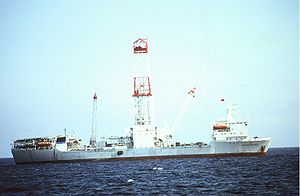
Strogov: Well, the civilian sailors.
Titovnin: Understood.
Strogov: The border guards. What ships do we now have near Moneron Island, if they are civilians, send [them] there immediately.
There is consistency of Strogov’s site identification with Kornukov’s. Both generals simply specify it as “Moneron.” Ships that are already “near Moneron” are sent to Moneron itself. This transcript puts the lie to the Soviet claims, from Day One and on, that they did not know where the plane went down, as well as exposing the Soviet deception in staging their search and rescue operations in various parts of international waters. Among the first proponents of this lie was Marshal Nicolay Ogarkov, U.S.S.R. Chief of General Staff, when he stated on September 9, 1983, at a press conference, "We could not give the precise answer about the spot where it [KAL 007] fell because we ourselves did not know the spot in the first place." The United States (and the rest of the world for the matter) had been effectively and tragically duped!
From V. Chebrikov, KGB head, and D. Ustinov, Defense Minister, to Yuri Andropov, General Secretary of USSR, December 1983 (see fuller text below):
"The fact that the recorders are in possession of the USSR shall be kept secret... As far as we are aware neither the US nor Japan has any information on the flight recorders. We have made necessary efforts in order to prevent any disclosure of the information in future.
"Looking to your approval. D.Ustinov, V.Chebrikov"
Moneron[edit]
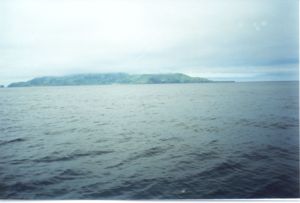
Moneron is an island just 4 1/2 miles long and 3 1/2 miles wide 24 miles due west of Sakhalin Island; the only land mass in the whole Tatar (Tsushima) straits. On its east side, its Soviet claimed 12 mile territorial boundary meets the west side of Sakhalin Island's 12 mile territorial boundary so that there is a contiguous 24 mile expansive of Soviet territory. It was in this area that reports coming to the Israeli Research Centre for Prisons, Psych-Prisons and Forced Labor Concentration Camps of the USSR indicated that KAL 007 had made a water ditching. And it was in this area that there was a southerly flowing current (West Sakhalin Convergent Current) to the Tsushima straits needed to explain the fact that some debris wound up on Hokkaido, Japan beaches south of Moneron. The Allied search operations were confined to international waters to the north of Moneron where the current of the Tsushima flows north rather than south.
The U.S. Search and Rescue mission was prevented by the Soviets from entering their territorial water anywhere around Moneron. Rear Admiral Walter T. Piotti (Photo [10]), Commander of Task Force 71 of U.S. 7th Fleet, stated in his After Action Report (Department of the Navy, Commander, Surface Combat Force Seventh Fleet. CTF75/N32:kpm,4730,Ser 011, 15 November 1983)
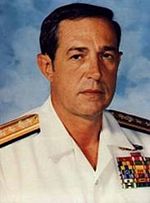
"Had TF [task force] 71 been permitted to search without restriction imposed by claimed territorial waters, the aircraft stood a good chance of having been found. No wreckage of KAL 007 was found. However, the operation established, with a 95% or above confidence level, that the wreckage, or any significant portion of the aircraft, does not lie within the probability area outside the 12 NM area claimed by the Soviets as their territorial limit.”
(For the full extent the naval confrontation between the Soviet and U.S. forces, see The Soviet/ U.S naval confrontation)
At a hearing of ICAO on Sept.15, 1983, Lynn Helms, Federal Aviation Administrator, stated:
"the U.S.S.R. has refused to permit search and rescue units from other countries to enter Soviet territorial waters to search for the remains of KAL 007. Moreover, the Soviet Union has blocked access to the likely crash site and has refused to cooperate with other interested parties, to ensure prompt recovery of all technical equipment, wreckage and other material."[15]
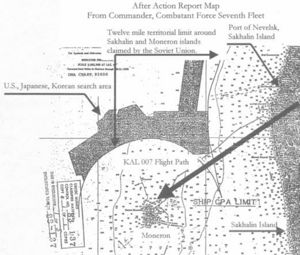
No bodies or luggage[edit]
It was thought that since the Soviets claimed that they had retrieved no bodies, body parts or tissues from the surface of the sea in their territorial waters and the U.S. search and rescue operation yielded the same lack in the international waters where they could search, then the bodies of the occupants of KAL 007 would be found below the sea trapped in their watery tomb, the remains of KAL 007. Yet, former Soviet Divers reporting in Izvestia (Dec. 1991) of their visit to KAL 007 at the bottom of the sea, beginning 15 days after the shootdown (while Soviet vessels above and a few miles away in international waters pretended to be searching for KAL 007) were amazed that out of a passenger plane carrying 269 people, there was only one torso. (Reports to the Israel Research Center for Prisons, Psych-Prisons, and Forced Labor Concentration Camps of the U.S.S.R. were that passengers and crew were abducted and then KAL 007 sunk to simulate an aircraft having crashed into the sea).
One of the divers, Viyacheslav Popov:
"I will confess that we felt great relief when we found out that there were no bodies at the bottom. Not only no bodies; there were also no suitcases or large bags. I did not miss a single dive. I have quite a clear impression: The aircraft was filled with garbage, but there were really no people there. Why? Usually when an aircraft crashes, even a small one... As a rule there are suitcases and bags, or at least the handles of the suitcases."
Another of the divers, V. Zakharchenko:
“But the main thing was not what we had seen there but what we had not seen—the divers had found practically no human bodies or remains…”.
Capt. Mikhail Girs:
“So we were ready to encounter a virtual cemetery. But one submergence went by, then the second, and then the third...During the entire rather lengthy period of our work near Moneron, I and my people had maybe ten encounters with the remains of Boeing passengers. No more than that.”(There is no way of ascertaining from this testimony if the “ten encounters” were with ten separate human remains, that is, individuals, or, more likely, ten encounters with a lesser number. It is entirely possible that these encounters were with fragments from the same individual).
According to Izvestia, the divers had only 10 encounters with passenger remains (tissues and body parts) including one partial torso. ICAO also interviewed a number of these divers for its 1993 report: "In addition to the scraps of metal, they observed personal effects, such as clothing, documents and wallets. Although some evidence of human remains was noticed by the divers, they found no bodies."
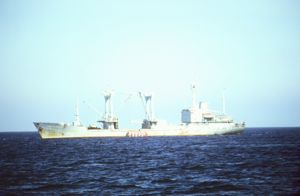
The Deployment of the Soviet simulated search fleet[edit]
At the same time that the Soviets were harassing the U.S. search efforts, the Soviets were conducting simulated search operations themselves. Admiral Vladimir Vasilyevich Sidorov, Commander of the Soviet Pacific Fleet, directed the simulated (see below) Soviet Search and Salvage operations, having the civilian divers as well as the military under his direct command.
The main Soviet salvage ship was the Mikhail Mirchink (pictured above). Designated an S.P.D., Self Propelled Drill ship, the Mirchink was a Swedish built vessel having the great advantage of being able, thanks to its gyros, to stabilize itself dynamically over one spot, regardless of wind or waves.The Mirchink had been positioned mainly within Soviet waters about eleven nautical miles north of Moneron. More than nineteen underwater operations had been performed from her decks. The divers working off the Mirchink had been flown, immediately after the shootdown, by helicopter from their deep-sea assignment off the shores of Murmansk on the Kola Peninsula in northwest Russia and then by transport to the port of Kholmsk on the island of Sakhalin for their “Flight 007” assignment.
The Hydronaut (Gidronaut), was a combined search and fishing boat, which was mother ship to two small two-man submersibles, the Tinro 2 and the Okeanolog. It's divers had also been hastily flown, this time from Crimean Sevestapol on the Black Sea shores of the Ukraine. The Tinro 2 made most of the dives. Its designer and commander was Capt. Mikhail Girs (see below).
The Georgi Kozmin was the third ship but had been working before the two civilian manned ships. It had two manned and two unmanned submersibles and its divers were all military. The Georgi Kozmin had come from Soviet Gavan, the main naval port across the Tatar Straits from Sakhalin. It was understood by civilian Soviet divers that anomalies such as missing bodies and luggage, could have been caused by these military divers working before them. See the latest report (Oct. 1, 2000) from one of the divers who visited KAL 007 at the bottom shortly after the shootdown and who found no bodies and no luggage [16]
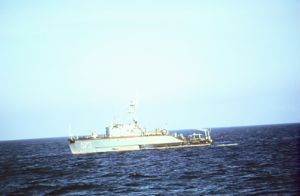
In the now unclassified “Surface Combatant Forces—7th Fleet Task Force 71 Flight 007 After-Action Report”, dated November 18, 1983, Commander Piotti would summarize the Soviets’ Search and Salvage operations:
“Within six days of the downing of KAL 007, the Soviets had deployed six ships to the general crash site area. Over the next 8 weeks of observation by U.S. naval units this number grew to a daily average of 19 Soviet naval, naval-associated and commercial (but undoubtedly naval subordinated) ships in the Search and Salvage (SAS) area. The number of Soviet ships in the SAS area over this period ranged from a minimum of six to a maximum of thirty-two and included at least forty-eight different ships comprising forty different ship classes.”
Five Theories for the missing bodies[edit]
Military diver removal theory: Russian deep sea diver Vadim Kondrabaev, one of the civilian divers brought to explore the wreckage of KAL 007 in 1983 gave an interview to the Russian magazine Itogi published on October 1, 2000. He points out that after he and the other civilian divers were brought to Sakhalin on September 10, 1983, they were kept there until "the end of September." "...They literally forgot about us for several days." When they did get to the wreckage, they were surprised to find neither bodies nor luggage. "We worked beneath the water almost a month for 5 hours a day and didn't find one suitcase, not even a handle from them." He suggests that the bodies were removed by the Naval divers who had worked before they,the civilian divers, and that they were brought in "as a smoke screen".
"It is quite possible that several mini submarines with military divers went down to the Boeing even before us and collected everything, and scattered the remaining parts of the destroyed liner about or left them there where they were needed, and afterwards called us as a smoke screen.[11]
The Spy Complement Theory: The earliest theory for the absence of bodies was that there were no bodies found because KAL 007 had but a small complement of military personnel and no civilian passengers. This first version of the spy plane theory was by and large discarded by September 9, 1983, when Marshal Nicolay Ogarkov, U.S.S.R. Chief of General Staff and First Deputy Defense Minister, conceded that there had been civilian passengers aboard KAL 007 (press conference of September 9, 1983, as quoted by Moscow Radio of the same date).
"It has been proved irrefutably that the intrusion of the plane of the South Korean Airlines into Soviet airspace was a deliberately, thoroughly planned intelligence operation. It was directed from certain centers in the territory of the United States and Japan. A civilian plane was chosen for its deliberately disregarding, or, counting on the loss of human life."
The Crab Theory: It was a claim by the Soviets that the reason for the missing bodies was the large amount of crabs in the debris area. Yet, as Professor William Newman, marine biologist, explains
"Even if we proceed from the supposition that crustaceans, or sharks, or something else fell upon the flesh, the skeletons should have remained. In many cases, skeletons were found on the sea or ocean floor, which had sat there for many years and even decades. In addition, the crustaceans would not have touched bones.” [17]
Neither would they have consumed luggage.
The Decompression Theory:This theory had more force, before the black box tapes analysis showed that the total extent of a missile caused ruptures (even when put all together in one area) to KAL's fuselage was only 1 3/4 sq. feet - too small for anyone to be sucked out.
Capt. Mikhail Girs: “Something else was inexplicable to us—zipped up clothes. For instance, a coat, slacks, shorts, a sweater with zippers—the items were different, but— zipped up and nothing inside. We came to this conclusion then: Most likely, the passengers had been pulled out of the plane by decompression and they fell in a completely different place from where we found the debris. They had been spread out over a much larger area. The current also did its work.”
The Wind Tunnel Theory: Lieutenant General Valeri Kamenski, Chief of Staff and Deputy Commander of the Ukrainian Air Force and formerly Chief of Staff of the Soviet Far East Military District Air Defense Force, the strategic commander of the shootdown, indicating in an interview (Facti I Kommentari [Ukrainian weekly], March 15, 2001) that what happened to the bodies of the crew and passengers of KAL 007 still constitutes a mystery, suggested a third possible explanation.
“It is still a mystery what happened to the bodies of the crew and passengers on the plane. According to one theory, right after the rocket’s detonation, the nose and tail section of the jumbo fell off and the mid fuselage became a sort of wind tunnel so the people were swept through it and scattered over the surface of the ocean. Yet in this case, some of the bodies were to have been found during the search operations in the area. The question of what actually happened to the people has not been given a distinct answer.”[18]
The finds at Wakkanai and Hokkaido beaches[edit]
Eight days after the shootdown, human remains and debris from within an aircraft appeared on the north shore of Hokkaido, Japan. Hokkaido began about 30 miles (48 km) below the southern tip of Sakhalin across the Soya Straits. From the southern tip of Sakhalin was 35 miles (56 km) up the west coast of Sakhalin to Moneron ). ICAO concluded that these objects were carried from Russian waters to the Japanese shores of Hokkaido by the southerly current west of Sakhalin Island. All other currents of the relevant east Tsushima straits, including the currents of international waters North of Moneron where the U.S. search operations were conducted, flow to the northward. This southerly current [19] between Moneron Island and Sakhalin Island could have been the way for debris to have arrived at Hokkaido, and this was the location for which reports had come in to the Israeli research center indicating that KAL 007 had come down. .
These human remains, including body parts, tissues, and two partial torsos, totaling 13 pieces in number. All were unidentifiable. One partial torso was that of a Caucasian woman - indicated by auburn hair on a partial skull, and one partial body was of an Asian child (with glass imbedded (KAL 007: Cover-up, David Pearson, Summit Books, New York, 1987, Pg. 234) There was no luggage recovered. Of the non human remains that the Japanese recovered were various items including dentures, newspapers, seats, books, 8 "KAL" paper cups, shoes, sandals, and sneakers, a camera case, a "please fasten seat belt" sign, an oxygen mask, a handbag, a bottle of dish washing fluid, several blouses, an identity card belonging to 25 year old passenger Mary Jane Hendrie[20] of Sault Ste.
Mid-air explosions or plane crashes at sea display a diffused pattern.. In these instances, almost immediately after the crash or midair explosion, there is an indiscriminate mixture of flotsam and debris at the crash site. This admixture is made up of:
1. Bodies, body parts, and body tissues (sometimes in the thousands);
2. Various articles which were with or on the persons of the passengers such as wallets, purses, identity and other cards, electronic portable devises, eyeglasses;
3. Articles from or part of the cabin itself, such as sweaters, jackets, dinner trays, life vests, cups, magazines, signs such as "fasten seat belts", hand luggage, food carts;
4. Articles from the cargo section of the aircraft such as suitcases, packing crates, cartons, sporting goods, musical instruments, industrial and electronic equipment; and
5. Various sized fragments of the aircraft itself.
The greater the altitude of the aircraft at the time of the explosion, or the greater the duration of breakup and disintegration in the air, even at lower altitudes, the more scattered and diffuse the flotsam and debris turned out. It is virtually impossible for there to be a midair explosion and subsequent crash at sea without these features obtaining.
The debris on Hokkaido could not have come from a catastrophic crash of KAL 007. The reason is that, of all the debris washed up on the shore or found in the waters, nothing appeared from any part of the aircraft but one - the passenger cabin area. No luggage or any other item from the jumbo jet's cargo portion such as suitcases, packing crates, cartons, sporting goods, musical instruments, industrial and electronic equipment appeared on the Hokkaido shores. It is possible that this debris, including the 13 unidentifiable human parts and tissues, had come as an intentional Soviet release during these early days of heighted cover-up and deception, and part of the disinformation spoken of in the Top Secret Soviet Memos to Andropov (see below).
Deception: Conclusion of the 1991 Staff Study of Committee on Foreign Relations[edit]
“Thus, our search efforts were in actuality little more than a charade being played out while the Soviets engaged in their own ruse of pretending themselves to “search” for a wreck they had probably already immediately located, stripped, probably sunk, and probably destroyed under water.” (pg. 65.)
“XIII CONCLUSION:
KAL 007 PROBABLY DITCHED SUCCESSFULLY, THERE MAY HAVE BEEN SURVIVORS, THE SOVIETS HAVE BEEN LYING MASSIVELY, AND DIPLOMATIC EFFORTS NEED TO BE MADE TO RETURN THE POSSIBLE SURVIVORS.” Page 77
Shoes and the Romanenko involvement[edit]
On Monday, September 26, 1983, a delegation of seven Japanese and American officials arriving aboard the Japanese patrol boat Tsugaru, met a six-man Soviet delegation at the port of Nevelsk on Sakhalin Island. KGB Major General A. I. Romanenko, the Commander of the Sakhalin and Kuril Islands frontier guard, headed the Soviet delegation. Romanenko handed over to the Americans and Japanese, among other things, single and paired footwear. With footwear that the Japanese also retrieved, the total came to 213 men's, women's and children's dress shoes, sandals, and sports shoes. The Soviets said that all that they had retrieved, they had found floating in the water or washed up on the shores of Sakhalin and Moneron islands.


Family members of KAL 007 passengers would later state that these shoes were actually worn by their loved ones for the flight on that fateful night. Sonia Munder had no difficulty recognizing the sneakers of her children, one of Christian age 14 and one of Lisi age 17 [12], by the intricate way her children laced them. (Sonia confirmed to me personally that her children were wearing these shoes when they boarded the flight). Another mother says, "I recognized them just like that. You see, there are all kinds of inconspicuous marks which strangers do not notice. This is how I recognized them. My daughter loved to wear them." And yet another mother, Nan Oldham, identified her son [13], John's sneakers from a photo in Life magazine of 55 of the 213 shoes—apparently, a random array on display those first days at Chitose Air Force Base in Japan. "We saw photos of his shoes in a magazine," says Nan, "We followed up through KAL and a few weeks later, a package arrived. His shoes were inside: size 11 sneakers with cream white paint." John Oldham had taken his seat in row 31 of KAL 007 wearing those cream white paint spattered sneakers. He had just come from painting his suburban Washington, D.C., family home.
From an examination of the shoes in the photo of Life magazine, pairing the sets and counting them with the single shoes, and relating them to the whole, it turns out that the total amount of shoes retrieved account for 198 of the 269 people of KAL 007 - or almost 74% of the total.
The Soviets retrieved the shoes of some portion of this 74% of the flight's passengers, yet claimed not to have found one single body, not one person. This adds great weight to the question "Where are the bodies?" Either the shoes were on the bodies and removed by the Soviets (or the Japanese), or they were removed by the wearers and retrieved by the Soviets (or Japanese). Why were these shoes loose? Were they taken off in preparation for the landing or were they simply removed during the course of the flight? In either case, the one great question remains. Is it really possible for so many shoes to be found and not one single person found to wear them? And if we should negate that the shoes were taken off in preparation for a ditching - that there was no time to do so, or the aircraft was in an exploded and too disintegrated condition to do so, then another question arises - If the non appearance of bodies is explained by their flesh being eaten by crabs, and, contrary to expert opinion, bones eaten by sea creatures, is it really credible, that not one of the 213 items of footwear had a foot, or a toe or a toe bone within it?
Gen. Romanenko would meet a bad end due to his handling of KAL 007 matters (possibly in the removal of the black box). The Republican Staff Study reports that he was probably sent to the Gulag himself. The Israeli Research Centre for Prisons, Psych-Prisons, and Forced Labor Concentration Camps of the USSR, resting on informant information, reported, independently and prior to the Staff Study, that Romanenko's name no longer appears in KGB computers. (Once in, a person is noted as reassigned, deceased, retired, etc., but never deleted. It is as if Gen. Romanenko never existed). And finally, Hans Ephraimson-Abt, the head of the American Association for the Families of KAL 007 Victims, reports that while he was in East Germany at the Soviet embassy on Association matters, he was informed by embassy officials that Gen. Romanenko, whom he had come to enquire about (he had not!), had committed suicide. Each in its own time, could have been true.
The Soviet Deception at Sea[edit]
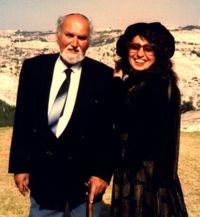
Reports had come in to Avraham Shifrin, Director of the Research Centre for Prisons, Psych-Prisons, and Forced Labor Concentration Camps of the USSR, charged with the debriefing, through the Jewish Agency, of former military men who were immigrating to Israel in the early 1990s that KAL 007 had been tracked by Soviet radar on the Siberian Maritime and had made what Soviet officers believed to be a safe Water Ditching off Moneron Island. (For a subsequent interview of one of the soldiers from a Soviet radar station that had tracked KAL 007 to what was believed to have been a safe water landing, see A Tracking of KAL 007 to Water: An Interview). Subsequent reports coming into the Research Centre from Russia itself indicated that the passengers and crew were abducted from the crippled and downed airliner, and the aircraft sunk and exploded under water with its wreckage scattered to simulate a plane having fallen from the skies. The appearance of secondary placement of the wreckage of KAL 007 was confirmed by some of the divers' reports:
Capt. Girs: "Aircraft pieces, wing spars, pieces of aircraft skin, wiring, and clothing. But—no people. The impression is that all of this has been dragged here by a trawl rather than falling down from the sky…"
Diver Viyacheslav Popov: "As we learned then, before us the trawlers had done some ‘work’ in the designated quadrant. It is hard to understand what sense the military saw in the trawling operation. First drag everything haphazardly around the bottom by the trawls, and then send in the submersibles?...It is clear that things should have been done in the reverse order.”[21]
These were some of the reports conveyed to Senator Jessie Helms of the Senate Committee on Foreign Relations and which prompted him, according to Helms' chief of Staff Admiral Bud Nance, to write to Boris Yeltsin concerning KAL 007.[22]
The Top Secret Soviet Memos[edit]
(For the memos in their entirety see [14])
In 1992, Russian president Boris Yeltsin disclosed five top-secret memos dating from late 1983, within weeks of the downing of Korean Air Lines Flight 007. These memos were published in the Soviet news magazine, Izvestia #228, October 16, 1992, shortly after being made public. The Soviet's own recording (from KGB head V. Chebrikov and Defence Minister D. Ustinov to Premier of Soviet Union Y. Andropov) of their deception of the U.S. fleet and the world, confirming that while they were pretending to search and while they were harassing the U.S. fleet [15], they already knew where KAL 007 was, had already boarded her, and had secured for themselves the sought after "Black Box":
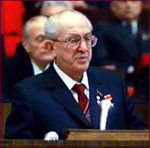
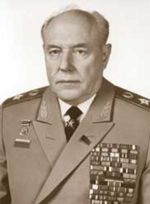
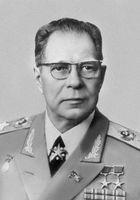
"Simulated search efforts in the Sea of Japan are being performed by our vessels at present in order to dis-inform the US and Japan. These activities will be discontinued in accordance with a specific plan...
"...Therefore, if the flight recorders shall be transferred to the western countries their objective data can equally be used by the USSR and the western countries in proving the opposite view points on the nature of the flight of the South Korean airplane. In such circumstances a new phase in anti-Soviet hysteria cannot be excluded.
"In connection with all mentioned above it seems highly preferable not to transfer the flight recorders to the International Civil Aviation Organization (ICAO) or any third party willing to decipher their contents. The fact that the recorders are in possession of the USSR shall be kept secret...
"As far as we are aware neither the US nor Japan has any information on the flight recorders. We have made necessary efforts in order to prevent any disclosure of the information in future.
"Looking to your approval.
"D.Ustinov, V.Chebrikov
"____ December 1983"
(From Top Secret Memos disclosed in 1992 by Boris Yeltsin and published in Izvestia, #228, Oct. 16, 1992., Cited in Christopher Andrew, "KGB Foreign Intelligence from Brezhnev to the Coup," Intelligence and National Security, vol. 8, no. 3 (July 1993), p. 60." and by Benjamin B. Fischer,Center for the Study of Intelligence (CIA), A Cold War Conundrum, 1997)
The Russians caught in their lie[edit]
The Top Secret Memos to Andropov (Dec. 1983) clearly acknowledge that by Oct. 20, 1983, the Black Box and KAL 007 were in Soviet possession [from the Soviet Civilian Divers reports they were already down on Sept. 15!].
"On 20 October this year at the point with coordinate...In the third decade of October this year the equipment in question (the recorder of in-flight parameters and the recorder of voice communications by the flight crew with ground air traffic surveillance stations and between themselves) was brought aboard a search vessel and forwarded to Moscow by air for decoding and translation at the Air Force Scientific Research Institute."
Yet the Soviets continued the pretense of search through the first part of November! '
A recent (Sept. 1, 2003) acknowledgement of the Soviet deception of the U.S. and allied search and rescue mission for KAL 007 comes from the the Russian Federation government itself - from the Deputy Director of State Archives of Recent History. He acknowledges that Soviet forces participated in the futile search for KAL 007 while all along knowing where it was. See [16]
The Soviet Black Box Deception I: The Tapes[edit]
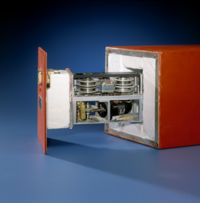
The ICAO Report released on Dec. 2, 1983 contained this statement by the Soviet Government, "No remains of the victims, the Instruments or their components or the flight recorders have so far been discovered" (Appendix F, ICAO 83). This was a lie as Boris Yeltsin's release of the earlier Nov. 1983 Memo from KGB head V. Chebrikov and Defense Minister D. Ustinov to Yuri Andropov, would show,
"In the third decade of October this year the equipment in question (the recorder of in-flight parameters and the recorder of voice communications by the flight crew with ground air traffic surveillance stations and between themselves) was brought aboard a search vessel and forwarded to Moscow by air for decoding and translation at the Air Force Scientific Research Institute." (Izvestia #228, October 16, 1992)
Thus, the Soviets not only had recovered the black box at least a month and a half prior to the time that they had reported to ICAO that there were no recovered "remains of the victims, the instruments or their components or the flight recorders", but their search up through the beginning of November for KAL 007 and the Black Box was seen to be a hoax. The Black box tapes eventually (after 9 years of denial) handed over to the ICAO investigators by the Russian Federation were of only the first minute and 44 seconds of KAL 007's post missile detonation 12 minute plus flight. The Russian Federation supplied military communications transcripts provide the rest of the documented flight showing that KAL 007 survived the missile attack and was able to maintain control, flying for nearly 5 minutes at level flight after pulling up from its dive, was able to maneuver, to turn north, to spiral down over the only available land site in the whole Tatar straits - Moneron Island. The mystery of how the stricken aircraft which should have hit the water in 2 1/2 minutes instead of over 12 minutes was solved. It had leveled out and flown for almost 5 minutes before beginning its spiral descent. That the return of only part of the Black Box tapes which exclude the actual capabilities of KAL 007 to maintain controlled flight was intentional and deceptive is suggested by the following:
1. Both components of the black box - the Cockpit Voice Recorder (CVR) and the Digital Flight Data Recorder (DFDR) - were operating after the missile detonation.
2. There is no evidence of impairment of the electrical system (High Frequency broadcast by KAL 007 to Japanese ground control after detonation of missile and all four engines reported by co-pilot to pilot to be operating normally.)
3. Both recorders "stopped" minutes prior to any conjectured aerial mishap that might have damaged the Black Box (substantiated by both radar tracking and military real-time communications). ICAO notes that the cessation of recordings occurring 1 minute and 44 seconds after missile detonation is consonant with a high speed impact while it also maintains that there was no impact at that time. There is no reconciliation of data supplied or suggestion as to what else might have caused the cessation of recording. (ICAO Report, 1993, pg. 30, paragraph 1.14.3.5.4)
4. Both recorders, with electric lines on opposite sites of the fuselage and with separate points of attachments to their respective instruments, "stopped working" at precisely the same second - an incredible unlikelihood. ICAO '93 analysis notes no known reason for this to have happened.
"Last Words" contradiction[edit]
Cockpit Voice Recorder tapes end, most often,with the successful flight arriving at the ramp of the airport of destination, or end recording the flight deck human agony and horror at impending catastrophe. The last words heard on the CVR tape are - 18:27:20: "Now... We have to set this. 18:27:23: speed 18:27:26: Stand by, stand by, stand by, stand by, set!"
These words are in stark contrast to the common types of last words uttered as an aircraft is about to crash, bringing to the fore the question, "Why did the Soviets not hand over the rest of the tapes recording the rest of KAL 007's flight?":
US Air Flight 427 September 8, 1994—Pittsburgh, Pennsylvania Flight 427, for reasons still unknown, has turned over onto its back and in another 16 seconds will hit the ground. Copilot: Oh, sh-t. Captain: Hang on. What the h-ll is this? Cabin: [Sound of stick shaker vibrations indicating imminent stall; sound of altitude alert.] Captain: What the… Copilot: Oh… Captain: Oh God, Oh God..Approach: USAir. Captain: Four twenty-seven, emergency! Co-pilot: [Screams.] Captain: Pull. Copilot: Oh...Captain: Pull… pull… Copilot: God… Captain:[Screams.] Copilot: No...
End of tape.
Yukla 27
September 22, 1995—Elmendorf Air Force Base, Alaska
Immediately upon takeoff, Yukla 27, an Air Force Boeing 707 configured as a radar E-3A, took several Canadian geese in engines one and two, disintegrating fan blades. All 24 aboard were lost in the ensuing crash.
Cabin: Yukla Two Seven heavy’s [indicating large or wide-bodied plane] coming back around for an emergency return. Lower the nose. Lower the nose.
Tower: Two Seven heavy, roger.
Captain: Goin’ down.
Copilot: Oh my God.
Captain: Oh sh-t.
Copilot: Okay, give it all you got, give it all you got. Two Seven heavy, emergency…
Tower: Roll the crash [equipment] roll the crash—
Copilot: [Over public address system] Crash [landing]!
Captain: We’re going in. We’re going down.
End of Tape.
Atlantic Southeast Airlines Flight 529 August 21, 1995—Carrolton, Georgia 21 minutes into its flight, Flight 529's left engine has fallen apart or exploded. Parts of the propeller blades are wedged against the wing and the front part of the cowling is destroyed. The captain and seven passengers will die. The copilot will survive with burns over 80% of his body.
Captain. [To copilot] Help me. Help me hold it. Help me hold it. Help me hold it.
Cabin: [Vibrating sound of the stick shaker starts warning of stall.]
Copilot: Amy, I love you.
Cabin: [Sound of grunting; sound of impact.]
End of tape.
(The Black Box, Malcom MacPherson (ed.) Quill William Morrow, New York: 1998)
These authentic last words coming from the flight decks of aircraft about to crash are in stark contrast to the "last words" coming from the Soviet recovered and retained and Russian Federation supplied tapes, "Now... We have to set this. Speed, stand by, stand by, stand by, stand by, set!"
The Soviet Black Box Deception II: The Black Box itself[edit]
The Soviets handed over only one minute and 44 seconds of the Black Box tapes. Both the Cockpit Voice Recorder and Digital Flight Data Recorder tapes which should have continued functioning until the end of the flight, whether by termination of the flight or by a crash, had "ceased simultaneously" (ICAO '93, 1.14.3.10.13). ICAO analysis of the Russian Federation supplied Black Box itself concluded that the damage to it "might have resulted from a high speed water impact" (1.14.3.4.2). But the conjectured "high speed water impact" would have been at or after the documented 12 minutes post attack flight, and not at one minute and 44 seconds after missile detonation. The possible "high speed water impact" can not explain, then, the fact that the tapes ceased at 1 minute and 44 seconds. The rest of the tapes would have documented what the Soviet high command saw on their screens, as shown by the Soviet military communications handed to ICAO by the Russian Federation - KAL 007 regaining control, maintaining level flight at 16, 242 ft, turning, and descending in a spiral around Moneron Island. Why had the rest of the tapes not been returned by the Soviets and where are they now?
There are credible but as yet unconfirmed reports of survivors in the former Soviet Union, including Congressman Larry McDonald.[23][24] Jewish immigrants to Israel from the former Soviet Union reported seeing survivors from the flight. According to reports, most of the adult passengers ended up in labor camps, while the children were adopted out and absorbed into Soviet society. Congressman McDonald was interrogated in Lubyanka Prison in Moscow for a time before he too was sent to forced labor.
Senator Jesse Helms and the POW and KAL 007 Connection[edit]
On December 5, 1991, Senator Helms wrote to Boris Yeltsin concerning U.S. servicemen who were POWs or MIAs,
"The status of thousands and thousands of American servicemen who are held by Soviet and other Communist forces, and who were never repatriated after every major war this century, is of grave concern to the American people."
Yeltsin would ultimately respond with a statement made on June 15, 1992, while being interviewed aboard his presidential jet on his way to the United States:
"Our archives have shown that it is true — some of them were transferred to the territory of the U.S.S.R. and were kept in labor camps... We can only surmise that some of them may still be alive."
On December 10, just five days after Senator Helms had written Yeltsin concerning American servicemen, he again wrote to Yeltsin, this time concerning KAL 007:
"One of the greatest tragedies of the Cold War was the shoot-down of the Korean Airlines flight KAL-007 by the Armed Forces of what was then the Soviet Union on September 1, 1983. . . The KAL-007 tragedy was one of the most tense incidences of the entire Cold War. However, now that relations between our two nations have improved substantially, I believe that it is time to resolve the mysteries surrounding this event. Clearing the air on this issue could help further to improve relations."
Helms appended to this letter the following interrogatories:
From Soviet reports of the incident, please provide:
- A list of the names of any living passengers and crew members from the airplane;
- A list of missing passengers and crew;
- A list of dead passengers and crew;
- A list and explanation of what happened to the bodies of any dead passengers and crew;
Please provide detailed information on the fate of U.S. Congressman Larry McDonald.
- How many KAL-007 family members and crew are being held in Soviet camps?
- Please provide a detailed list of the camps containing live passengers and crew, together with a map showing their location
Senator Helms' letter to Yeltsin was prompted, according to the Chief of Staff under Helms for the Minority Staff of the Committee on Foreign Relations, Rear Admiral Bud Nance, by the information from Israel, apparently verified by the CIA, concerning KAL 007 [17]
This short period in the presidency of Boris Yeltsin evidenced a relative openness toward the United States, a window of opportunity which would shut tight with the ascendancy of Vladimir Putin. Added to KAL 007 and the American POW matters, Yeltsin had exhibited openness in his acknowledgment that the plague that had struck Sverdlovsk on April 9, 1979 causing death to humans and livestock had not been due, as the Soviets had long claimed, to a rampant cow disease, but to a mishap at a military biological facility which released deadly anthrax into the atmosphere.
The Russian Black Box Acknowledgement[edit]
The Yeltsin "thaw" and the window of opportunity for the U.S. saw the following developments:
On March 24, 1992, Soviet Defense Minister Dmitri Ustinov admitted on Russian television that he had ordered an all-out effort to retrieve the black boxes in order to "prevent the United States from finding them and to save the Soviet Union from a flurry of international accusations for destroying a civilian airliner"
June 17, 1992, Yeltsin revealed the existence of a KGB memo reporting the existence of documents related to KAL 007. Speaking in Washington, Yeltsin said,
"It was a memorandum from (the) KGB to the Central Committee of the Communist Party where it says that such a tragedy has taken place, and so on and so forth, and that there are documents which would clarify the entire picture. And the next line then says these documents are so well concealed that it is doubtful that our children will be able to find them, those who come after us will be able to find them."(UPI, Washington, June 17, 1992)
On October 14, 1992 a delegation from the American Association For Families of KAL 007 Victims visited Moscow at the invitation of President Boris Yeltsin. During a State ceremony at St. Catherine's Hall in the Kremlin. The KAL 007 Family Delegation was handed a portfolio containing partial transcripts from the KAL007 Cockpit Voice Recorder .
November, 1992, President Boris Yeltsin handed the two Black Box containers to Korean President TohTae-Woo -but not the tapes themselves at the end of the plenary session of the Korean National Assembly with this statement, "We apologize for the tragedy and are trying to settle some unsolved issues."
January 8, 1993. The tapes themselves would be handed to ICAO. They would be deciphered and transcribed by the "Bureau d'Enquete et d'Analyses" (BEA) in Paris in the presence of representatives from Japan, The Russian Federation, South Korea,and the United States. And so the long years of Soviet denial had come to an end with the handing over of the tapes (but not all!) of KAL 007's Digital Flight Data Recorder and Cockpit Voice Recorder (See - [18])
Senator Jesse Helms, KAL 015, and the Grenfell children[edit]



Senator Helms, along with Senator Steven Symms of Idaho and Congressman Carroll Hubbard Jr. of Kentucky, had traveled on KAL 015 fifteen minutes behind KAL 007, and had stopped at Anchorage airport, as did Larry McDonald on KAL 007, and had gotten off KAL 015. McDonald did not get off. Reports indicate that Helms had contemplated changing to KAL 007 to be with him but decided against it. That near miss must have stayed with him as the outcome of the flight became apparent as KAL 015 arrived at Seoul Airport and KAL 007 did not. As he attended the 30th Year celebration of the U.S. Mutual Defense Treaty - and Larry Mcdonald did not. As the reports from Israel of survivors would come to his office 8 years later. As he would write to Yeltsin. As Yeltsin would comply with all the requests that Helms had made of him - excepting the fate of the passengers and crew, and especially, the sought after information about Larry McDonald.
One thing Helms could not forget and would speak of often, and mention in his letter to Boris Yeltsin, was a meeting at Anchorage airport while both KAL 007 and KAL 015 were taking on fuel for the next leg of the trip, a meeting that he had with two child passengers, Noel Anne Grenfell, aged 5, and her sister Stacy Marie, aged 3.[25]
"I’ll never forget that night when that plane was just beside ours at Anchorage airport with two little girls and their parents. I taught them, among other things, to say I love you in deaf language, and the last thing they did when they turned the corner was stick up their little hands and tell me they loved me. I’ll never forget that, and I know you won’t."
Who ordered the shoot-down[edit]
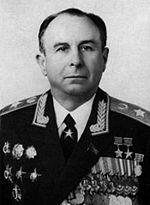
Who ordered the shootdown on the Soviet military side is fairly well known and on the political side, the lines leading up to the General Secretary of the Communist Party and head of the Soviet Union Yuri Andropov, can confidently be conjectured by "working up" the Soviet hierarchical system of command.
General Anatoli Kornukov, the Commander of Sokol Air Base on Sakhalin was the "tactical" commander of the shootdown and subordinate to the "strategic" commander of the shootdown - General Valeri Kamensky (General Kornukov would later become head of the Russian Air Force).
General Kamensky was the Commander of the Soviet Far East Air Defence forces and would have informed both
General Ivan Moseivich Tretyak [26] his direct superior and Commander of the Soviet Far East Military District as his direct commander, and informed the Commander-in Chief of Air Defense Forces at the National Command Center in Kalinin. This was Gen. Alexandr Koldunov. (Maj. Victor Belenko, who served in one of the units that brought 007 down, but who had defected to Japan in his MiG 25 in 1976, says that at the first intrusion of KAL 007 over Kamchatka, Gen. Kamensky would already have informed his superior at the National Command Center at Kalinin and the intruder would have been tracked on the screen there until it had left Soviet territory).
As this was an emergency, the Commander in Chief of Soviet Air Forces (VVS), Chief Marshal of Aviation Pavel Kutakhov would have been informed.
As the test of the illegal (Salt ll) SS-25 had been planned for that night with the missile coming down on the Klyuchi target range of Kamchatka[27] - where KAL 007 was to traverse in its first intrusion of Soviet territory- the head of the First Directorate of Strategic Concealment (Maskirovka), First Deputy Chief of Staff Marshal Sergei Akhromeyev would have been present for any decision.
Further, Chief of the Soviet General Staff and First Deputy Minister of Defense Nikolai Ogarkov would have been in on any decision and would have informed his immediate superior and link with the Political echelon, Minister of Defense Dmitri Ustinov.
It is then that Yuri Andropov would have been in position for decision for shootdown.
The telecommunications for this linkage up the Military and then Political chain of command would have been effected well within the hours starting at the first intrusion into Soviet controlled airspace - 1551 GMT (Missile detonation was at 18:26:02 GMT).
Conclusions and Aftermath[edit]
- The "black boxes" that were the data flight recorder and the cockpit voice recorder were hidden away for nearly ten years after their recovery by the Soviets, during which time they employed their own spin as to the nature of the flight. So damning was the black box evidence against them that they had hoped it would never see the light of day. Even Mikhail Gorbachev during his period of "glasnost" ("openness") kept assuring investigators that the black boxes did not exist.
- On December 10, 1992 Senator Jesse Helms wrote to Russian president Boris Yeltsin.
"One of the greatest tragedies of the Cold War," he wrote, "was the shoot-down of the Korean Airlines Flight 007 by the Armed Forces of what was then the Soviet Union on September 1, 1983. . . The KAL-007 tragedy was one of the most tense incidences of the entire Cold War. However, now that relations between our two nations have improved substantially, I believe that it is time to resolve the mysteries surrounding this event. Clearing the air on this issue could help further to improve relations.[28]" At about the same time a military memo boasting of the secret would make its way into Yeltsin's hands, leading to the discovery of the black boxes as well as the top secret reports about them by the Soviet Defense Ministry. Yeltsin would ultimately respond on January 8, 1993 by handing over to the International Civil Aviation Organization what the Russians had for so many years denied possessing: the tapes of the KAL 007's "Black Box" (its Digital Flight Data Recorder and Cockpit Voice Recorder).[29][30]
- Previous to the shootdown, the Reagan Administration was far from assured that the Administration supported NATO deployment of Cruise and Pershing II missiles in West Germany, just 6–10 minutes flight to Moscow, would go through. After the shootdown, deployment was assured and remained in effect until the accords with Mikhail Gorbachev allowed for their withdrawal. The shootdown can thus be seen as one of the main incidences leading to the confrontational Reagan policy in the "Second Cold War" which played its part in the backdown and demise of the Soviet Union.
- As a result of the perceived cause of KAL 007's flight deviation (Inertial Navigation System), President Reagan authorized the hitherto strictly military use of the Global Positioning System (GPS) for civilian use. The GPS is now used extensively for civilian passenger flights and for vehicular land travel.
- The immortal words of former UN Ambassador Jeanne Kirkpatrick's deputy Charles Lichenstein: Shortly after the Soviet Union shot down KAL 007, legislatures in New York and New Jersey denied Soviet aircraft landing rights. Some at the UN raised the question of whether that body should remove from the United States. And Lichenstein, fed up and in no mood for "diplomacy," said, "We will put no impediment in your way. The members of the US mission to the United Nations will be down at the dockside waving you a fond farewell as you sail off into the sunset."
- The attempted landing of KAL 007 with the reported survival rate of zero percent presents the following anamoly: it would be the only documented incident, in all of aviation history, of an intentional water landing of a passenger plane, under any emergency situation, where there have been no survivors. See Water Ditching, Miracle on the Hudson and KAL 007, and Passenger Plane Crashes at Sea
Korean Airlines Flight 007 was a victim of the Cold War, a flight that had possibly simply gone off course in the wrong place and at the wrong time. Careless discrepancies by the plane's pilot combined with Soviet paranoia helped to end, reportedly, the lives of 269 passengers and crew.
Passenger and Crew Breakdown[edit]
Republic of Korea 105, United States 62, Japan 28, Taiwan 23 Philippines 16, Hong Kong 12, Canada 8, Thailand 5, Australia 2, United Kingdom 2, Dominican Republic 1, India 1, Islamic Republic of Iran 1, Malaysia 1, Sweden 1, Vietnam 1 (ICAO '93, 1.3, Pg. 6).
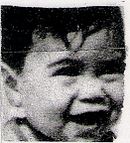

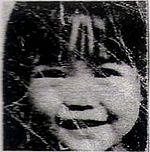

See [19] for breakdown of identities, with photos and stories by relatives and friends, for passengers, flight crew, flight attendants, security (air marshals), and deadheaders (repositioning KAL employees). See [20] for photos of passengers who had boarded the plane but who have not been linked to passenger list and remain unidentified.
Further reading[edit]
- Dallin, Alexander. Black Box: KAL 007 and the Superpowers, University of California Press, Berkeley, CA (1985)
- Hersh, Seymour M. The Target is Destroyed, Vintage, New York (1987)
- Schlossberg, Bert. Rescue 007: The Untold Story of KAL 007 and its Survivors, Xlibris Corporation, Philadelphia, PA (2001)
- FBI files on the incident obtained via the Fredom of Information Act
- Timothy W. Maier's article "KAL 007 Mystery", from Insight Magazine
- Transcript of the cockpit voice recorder
- "Atrocity in the Skies", Time Magazine, September 12, 1983
- "CIA" report, suggesting the plane did not crash and the survivors were interned
- The Cold War, KAL-007 & Communism: Intelligence Secrets Revealed
- Solovev, Vladimir, and Klepikove, Elena. Behind the High Kremlin Walls, Dodd Mead, New York (1986). ISBN 0396087108
See also[edit]
- Mass killings under Communist regimes
- The KAL 007 related Soviet/ U.S naval confrontation
- KAL 007: Soviet stalk, shoot down, and rescue mission orders transcripts
- KAL 007: the Russian Federation support for a water landing
- Soviet diver to KAL 007 says no bodies, no luggage
- Soviet deception in the search for KAL 007: a seaman's testimony
- The Soviet's Deception of the Location of KAL 007's Water Landing
- Essay: The KAL 007 Survivor Anecdotes
- U.S. Intelligence on KAL 007's Intrusion into Soviet Territory and the Shoot down
- KAL 007: Soviet stalk, shoot down, and rescue mission orders transcripts, Soviet real-time military communications and U.S./Japanese electronic intercepts
- KAL 007: Timeline of Events, Russian Regime changes, and Investigations
- KAL 007: Its Deviated Flight Until Attack
- Inertial Navigation System
- KAL 007: Timeline of Interception and Shootdown
- Attack on KAL 007: From Inside
- KAL 007/ Russian Ram attempt first person narrative of what it was like
- KAL 007: The Russian Explanations for the Missing Bodies
- KAL 007 and the Soviet Top Secret Memos
- KAL 007 on the Water: a sighting
- KAL 007:Floating Shoes
- Water Ditching
- Passenger Plane Crashes at Sea
- Essay: KAL 007 Survivors and Gulags of Russia
- Soviet Officers of KAL 007 Shootdown
- Ronald Reagan's speech on KAL 007
- The Stavitski Account
- KAL 007: Survivor reports and whereabouts
- Jesse Helms
- Jesse Helms: A Tribute
- History Channel Documentary on KAL 007: a critical review A study in Media misrepresentation
- Miracle on the Hudson and KAL 007
- A Tracking of KAL 007 to Water: An Interview The first former Soviet military debriefing report sent from Israel to Senator Jesse Helms
- Wikipedia prejudice and KAL 007
- Anatoly Kornukov
- The Zero Option A 2009 novel based partly on the findings of the International Committee for the Rescue of KAL 007 Survivors [21] - the tracking and rescue of Congressman Larry McDonald
- Moneron Island
- Sakhalin
- The Soviet/ U.S naval confrontation
- KAL 007: A short summary of evidences
- Avraham Shifrin: KAL 007 Researcher/ An Essay
- Korean Air
References[edit]
- ↑ For passenger (and crew) seating, photos, and stories for some, written by family and loved ones see Rescue 007: Passengers.
- ↑ ICAO report 1993, p. 42, sect. 2.4.4.
- ↑ ICAO 1983, p. 45. Section 2.9.1.
- ↑ Rescue 007: Kamenski Interview
- ↑ The complete transcript of the orders to destroy KAL 007 are available at Rescue 007:The Stalk.
- ↑ See Rescue 007:The Shootdown for the combined U.S. electronic intercept and Soviet military communications of the actual shoot-down with photos of key personnel.
- ↑ ICAO '93, Information Paper 1., pg. 93
- ↑ UNITED STATES COURT OF APPEALS FOR THE SECOND CIRCUIT Nos. 907, 1057 August Term, 1994 {Argued: April 5, 1995 Decided: July 12, 1995, Docket Nos. 94-7208,94-7218}
- ↑ http://www.time.com/time/magazine/article/0,9171,926169,00.html
- ↑ http://www.time.com/time/magazine/article/0,9171,954035-2,00.html
- ↑ http://www.rescue007.org/photo_essay.htm
- ↑ http://www.time.com/time/magazine/article/0,9171,954035-7,00.html
- ↑ [1][2]
- ↑ http://www.rescue007.org/rescue.htm
- ↑ Congressional Record, Sept. 20, 1983,pgs S12462-S12464.
- ↑ http://www.royfc.com/news/oct/0001oct01.html
- ↑ http://www.rescue007.org/docs/Russian Explanations for the Missing.pdf
- ↑ http://www.rescue007.org/kaminski.htm
- ↑ http://www.pices.int/publications/scientific_reports/Report12/kantakov_f.pdf
- ↑ http://www.rescue007.org/mary_jane_hendrie.htm
- ↑ [3]- pgs 10,11.
- ↑ http://www.rescue007.org/nance_letter.htm
- ↑ http://www.rescue007.org/faq.htm#10
- ↑ http://www.rescue007.org/survivors_of_kal_007.htm
- ↑ http://www.rescue007.org/grenfells.htm
- ↑ http://www.rescue007.org/rescue.htm
- ↑ http://www.rescue007.org/how_kal_007_was_lost.htm
- ↑ http://www.rescue007.org/helms_letter.htm
- ↑ https://web.archive.org/web/20010919141246/www.insightmag.com/archive/200104171.shtml
- ↑ http://www.jamesoberg.com/russian/kal007.html
External links[edit]
- A Forgotten Man: Congressman Larry McDonald
- "KAL 007: The Real Story", article by James Oberg, American Spectator Magazine, October 1993
- Page devoted to the flight and to the possibility that there may have been imprisoned survivors
- Interview with Gennadi Osipovich, the pilot who shot down the plane (December 9, 1996)
- NASA report on autopilot error
- Obituary of Soviet Marshal Ogarkov
- The website of the International Committee for the Rescue of KAL 007 Survivors
- Article at Airliners.net
- All eight of the Airliners.net articles about KAL 007 are accessed from this page
- Critique of History Channel documentary on KAL 007
- AIM column on KAL 007 - "Let's Ask Putin"
- AIM Column on KAL 007 - "Put it to Putin" Accuracy in Media article prior to AIM petition to Russian Embassy in Washington
- AIM column on KAL 007 - "Questions for President Putin"
- New AIM report on KAL 007 "Hold Russia Accountable For KAL 007 Shootdown"
- "KAL Flight 007 Remembered" New American Magazine
- The 25th Anniversary of KAL 007, Airliners.com
- USS Sterett: First hand account of US-Soviet naval oonfrontation with real-time photos
- USCGC Munro and the Korean Airliner (KAL 007)
- "Unresolved Questions Surround KAL 007" New American Magazine
- "Larry McDonald - An American Hero Remembered", New American Magazine
Video Links[edit]
- KAL 007 intro/Larry McDonald on Crossfire in 1983
- YOUTUBE presentation on KAL 007 and mystery
- President Reagan's address to the country, September 5, 1983
- CNN archives on KAL 007
- Discovery Channel program "Unsolved History: Flight KAL 007"
- KAL 007 Search and Recovery Operations USS Sterett CG 31 1983
Categories: [KAL007] [Aviation] [Cold War] [Featured articles]
↧ Download as ZWI file | Last modified: 02/06/2023 04:39:00 | 12 views
☰ Source: https://www.conservapedia.com/Korean_Airlines_Flight_007 | License: CC BY-SA 3.0
 ZWI signed:
ZWI signed: KSF
KSF